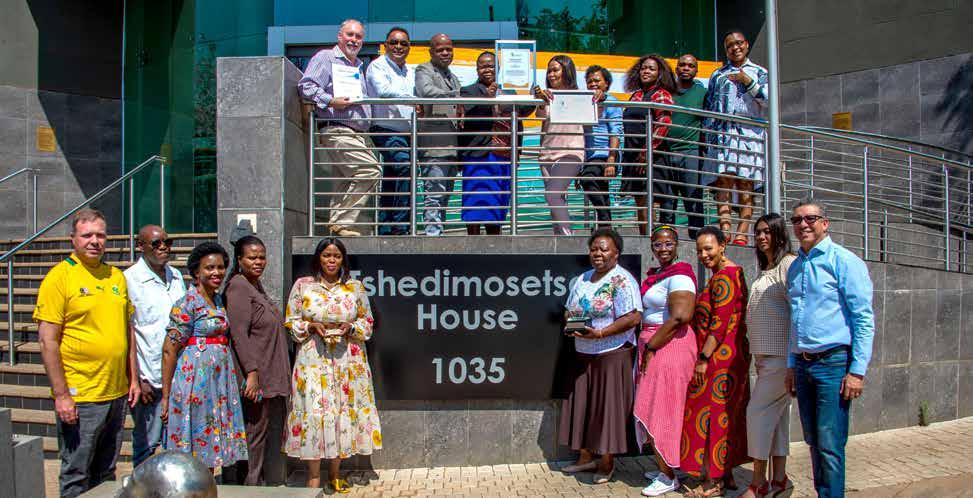Fighting COVID-19
























This book is dedicated to all government communicators and members of the media who lost their lives during the Coronavirus Disease (COVID-19) pandemic in pursuit of bringing vital information to our citizens.
It is also dedicated to the late Minister in The Presidency, Mr Jackson Mthembu, for steering the department under challenging conditions in the fight against COVID-19.
(5 June 1958 – 21 January 2021)
The COVID-19 pandemic caused severe human suffering and took many precious lives from us, including the late Minister in The Presidency, Mr Jackson Mthembu. He passed on at the height of the pan demic from health complications related to COVID-19.
Our nation lost one of its finest public servants and government communica tors. His death robbed us of a decisive leader and servant of the people who led the government communication system through one of the most difficult times in our history. As the face of government communication, Minister Mthembu un derstood that clear, effective and honest communication was critical to keeping South Africans updated on government’s response to the COVID-19 pandemic.
Based on these key communication ten ets, he led the government communica tion system through the unprecedented crisis. The Minister was the nexus between the National Coronavirus Command Council (NCCC) and communicators on the ground while being at the forefront of providing valuable content to South Afri cans. His untimely passing left us with a massive void.
His contribution to our nation in one of our most challenging moments will never be forgotten. We remember his decisive leadership and willingness to go over and above the call of duty. His approachable, considerate, diplomatic, strategic and above all, down-to-earth nature, was in strumental in our nation reaching our communication goals during the COV ID-19 period.
He was always positive no matter the challenges and had confidence that we would prevail and emerge stronger as a nation. He engaged constructively with the GCIS management and staff to ensure that the department achieved the best outcomes.
His life is a testimony that one person can make a difference. He was dedicated to building a better tomorrow for our peo ple and inspired others to do the same.
Minister Mthembu left an indelible mark on the government communication fra ternity and set the tone for government communication to forge ahead into the future.
He dedicated his life to our country and its people, and worked tirelessly towards creating a better South Africa until his untimely passing.
He lived the values of unity, selflessness, collective leadership and honesty. The Minister left a unique imprint on the type of public service we continue to strive to build.
It is now the duty of every public serv
ant, particularly government commu nicators, to keep his legacy alive. To take Minister Mthembu’s legacy for ward, communicators are encouraged to rise to the challenge to propel the government communication system into
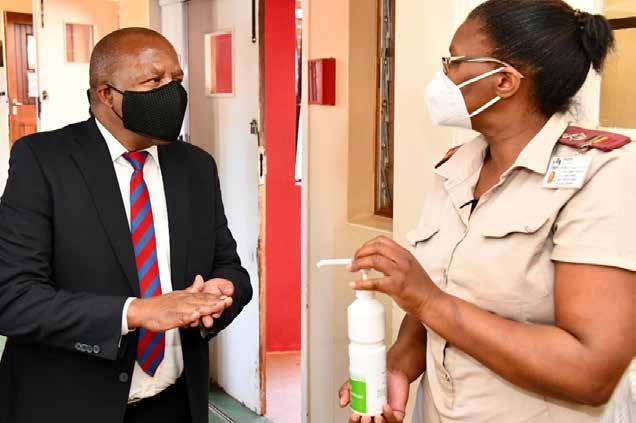
the heart of service delivery.
In order for government communica tion to keep his legacy alive, communica tors are reminded of the important role communication plays in inspiring our cit izens.
Our task as communicators is to convey a message that is anchored in hope and confidence. Let us follow in the footsteps of Minister Mthembu by putting our na tion and her people first.
Our nation will forever be indebted to Minister Mthembu not only for the role he played in our struggle for national libera tion but also in driving back the spread of an unyielding virus in the early days of the COVID-19 pandemic. We salute him and honour his profound legacy.
Mr Mondli Gungubele, MP Minister in The PresidencyThis e-book captures the work of South African communication professionals and partners in the fight against the devastation of the COVID-19 pandemic. It not only details the resilience and robustness of the communication systems, but serves as a legacy of communication for future generations.
The pandemic severely affected every facet of people’s lives and forced everyone to adopt new ways of doing things. It also affected how governments around the world communicated with the public.
The reality is that nobody anticipated a challenge of such magnitude, yet the crucial task of edu cating and reassuring the public remained paramount. Citizens were forced to adapt to a new way of living to protect themselves from the deadly virus and also find new ways to communicate.
The GCIS at the time faced the daunting reality of a constrained budget to run a communication campaign to reach over 60 million citizens. With no new funds available to support communication projects, the department had to use existing resources and innovative thinking to drive our commu nication campaigns forward.
This enormous challenge took an immense physical and mental toll on officials on the frontlines. In the first few days of the pandemic, especially soon after the initial declaration of the National State

of Disaster on 15 March 2020, most GCIS officials were overwhelmed with addition al work to ensure continuity in the work of government. Since the virus was rampant in those first few months, many fell ill and had to isolate for a few days. However, there
were no gaps or shortfalls as most com municators chose to forego their planned or annual leave to mitigate the shortage of staff. It is through such acts of solidari ty and selfless sacrifice that we were able to help save many lives through our ef fective communication.
Regular research undertaken by the GCIS guided the communication ap proach to ensure that it was relevant and accurate to meet specific information needs and respond to areas of concern. One of the distinguishing features of how government managed this pandemic was listening to the people and their concerns. We continually assessed our opera tions and amended our practices to best respond to various challenges. Through our development communication pro grammes – including community radio talk shows, door-to-door outreach cam paigns and mall and taxi rank activations
– we listened to the concerns of the peo ple.
Moreover, by taking information directly to the doorsteps of our communities, the GCIS was able to keep its finger on the national pulse and this sometimes acted as an early warning to issues emerging in the communities. We made adjustments to balance people’s concerns, knowing that we must continually do better for the people of our nation.
Our communication focused on instill ing behaviour change by daily profiling preventative measures to stop the spread of the virus. We encouraged people to be mindful of the impact of their own behav iour on the well-being of others, especial ly those most vulnerable to the virus such as the elderly and persons with comor bidities.
This was done in line with Section 195(g) of the Constitution of the Republic of
South Africa of 1996 to “foster transparen cy and provide the public with information that is timely, accurate and accessible”.
Faced with such a daunting task and confronted with an unseen enemy that took away our daily human interaction, we quickly migrated to new ways of work ing. In this period most meetings, confer ences, training sessions and workshops took place virtually or remotely.
While the move to virtual communica tion may have taken years to reach its full potential, it was amazingly fast-tracked in a matter of weeks and months. For in stance, the GCIS used Skype for Business and other virtual meeting platforms such as Zoom and Microsoft Teams for virtual engagements.
During this period, online licences were extended to include large meeting for mats and webinars, and social-media platforms were also used to live-stream media briefings and other government events. Most government communicators welcomed the arrangement to work from home during the pandemic.
Despite some technological flaws and glitches, we nevertheless transitioned to the digital and virtual world seamlessly.
We used digital platforms such as na tional portals, mobile apps and social me dia to spread information to South Afri cans with access to the internet.
“We used digital platforms such as national portals, mobile apps and social media to spread information to South Africans with access to the internet”
South Africans were able to watch live streams of press briefings and announce ments by government on the Govern ment Facebook page from the comfort of their homes. We also ensured that most media briefings were broadcast live to community radio stations that reached the far-flung rural areas in the country.
These new technologies dovetailed with more traditional methods such as loud hailing which was undertaken in partner ship with other spheres of government and agencies. The GCIS also used various government products and platforms such as Vuk’uzenzele newspaper, News Ser vice (SAnews), My District Today newslet
ter and Public Sector Manager magazine.
The GCIS also used community radio stations, particularly African language radio stations, to provide news and infor mation to people in their preferred lan guages.
Our comprehensive communication campaign also focused on media en

gagement, paid-for advertisements in electronic broadcasting, print, face-toface engagement and digital media plat forms.
As a vital partner, the media was pro vided with constant updates on what still was a fast-evolving situation. Through regular virtual meetings, press conferenc es and engagements we kept the media informed so that they could impart vital information to the public.
What this period showed more than an ything else is the power of partnerships which we fostered with civil-society or ganisations, particularly those working at the coalface to ensure that people are in formed about the importance of adhering to preventative measures such as regu larly washing hands with water and soap or using a 70% alcohol-based hand san itiser, keeping a safe distance and wear
ing a mask that covered both the mouth and nose.
Apart from assisting in spreading information about the importance of adopting the measures to prevent exposure to the virus, our stakeholders also helped us to deal with incidents of fake news and misinforma tion.
The work we achieved during this difficult period would not have been possible without the dedication and hard work of the staff and colleagues.
We shall also not downplay the gener ous support provided by our partners to save lives and drive a narrative of hope.
Ms Phumla Williams GCIS Director-General (DG)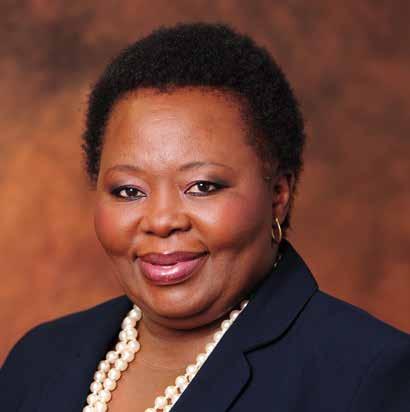
The advent of the COVID-19 pandemic plunged the entire world into unchar tered waters. While the virus was fought on many fronts, communication was at the centre of our nation’s efforts to prevent the spread of the deadly virus and thus save lives.
Our immediate realisation was that communica tion was an essential tool in the country’s mitigat ing strategy to combat the spread of the virus. The GCIS spearheaded the nationwide communication system that played an instrumental role in the fight against COVID-19. The highly effective communi cation campaign provided messages of hope to people in South Africa and guided their actions throughout the onslaught of the pandemic.
Government communication sought to inform, educate and reassure people in South African, as well as instil hope, that the country would emerge
stronger after the virus had subsided. Frequent communication focused on providing accurate, useful and up-to-date information to the public.
Through reliable information, South Africans were able to make informed decisions about their daily routines. The pandemic had changed the way government communicates and engages with its citizens, as face-to face or physical interactions were limited in line with national lockdown regulations. For the first time since the start of our democracy, many of the everyday freedoms South Africans enjoyed were curtailed in a bid to fight the spread of the virus. Religious services and traditional practices were also placed on hold.
To limit the spread of the virus, there was an unprecedented closure of activities such as sports, entertainment and public events.
The pandemic had also brought with it a deep sense of doubt and anxiety. Many people had lost their jobs and did not know how they were going to provide for their families.

Communication had to address these daily challenges as well as deal with mis conceptions about the spread of the vi rus. For example, in the early days there was a misconception that the virus only affected affluent citizens traveling inter nationally and that some citizens were immune from infection.
There was also a growing trend of fake news on social media that sowed roots of contention and undermined our na tion’s communication efforts. Widespread myths such as the COVID-19 vaccine containing a microchip or that it could change a person’s DNA had to be over come through effective communication.
When vaccines became available, a na tionwide communication initiative was activated to encourage people in South Africa to vaccinate to defeat the virus. Our communication highlighted that every citizen had a role to play in building the momentum needed to reach population immunity.

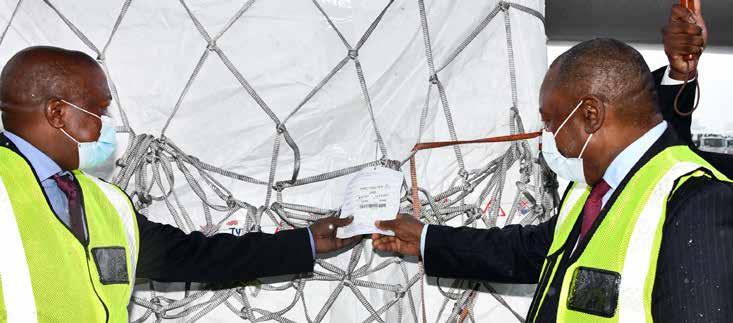
The pandemic was also a stark remind er of the importance of providing quality and reliable information at a time when fake news flourished, especially on social media. Government communication be came the vanguard in the fight against
misinformation and fake news, which posed a real risk to our nation’s efforts to fight the virus. Our communication push had been to constantly remind people that they are part of the solution.
Through communication, the GCIS played an important role in helping to limit the spread of the virus and fostering compliance by encouraging more people in South Africa to adhere to preventative and safety measures. This resulted in behaviour change as more people around the country adhered to preventative measures.
Research has shown that sustained heightened communication from both government and social partners has had a positive impact on behaviour change and vaccine uptake during the COVID-19 pandemic.
As early as the end of 2019, the GCIS was monitoring the COVID-19 situation in other parts of the world through extensive assess ment. The situation in Wuhan, China, the epicentre of the pan demic, was quickly deteriorating, with news emerging that South African students were stuck in the city.
The National Joint Operational and Intelligence Structure (NATJOINTS) was convened to deal with the repatriation of citizens from Wuhan. NAT JOINTS held several intense meetings, as often as two to three times a day, to plan for the repatriation of the students.
The GCIS was tasked to develop the communication plan and present the daily media environment report. The department, in partnership with the Department of International Relations and Cooperation, began communi cation on the repatriation of South Africans based in Wuhan.
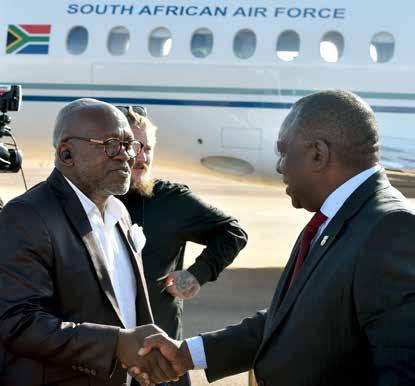
At the same time, the GCIS also be gan preparations on communication for a possible outbreak of COVID-19 in the country, which was spreading rampant ly across the world. Like the rest of the world at the time, there was a deep sense of apprehension and uncertainty.
The COVID-19 pandemic reached South Africa with the first case reported on 5 March 2020. Addressing the nation,
President Cyril Ramaphosa announced that the country would enter a nation al lockdown in an attempt to curb the spread of this new disease. Alert level 5 was enforced from midnight 26 March to 30 April 2020.
The anxiety among citizens was palpa ble as lockdown measures placed restric tions on their movement. GCIS prepara tions for the lockdown included creating
a WhatsApp group of communicators and arranging travel permits that would allow a core group of communicators to remain mobile.
The Communication Command Centre (CCC) was activated through the GCIS’s Cluster Coordination unit, which drew communicators from across the govern ment system. The GCIS also convened the communication and community mo bilisation work stream consisting of gov ernment communicators.

The work stream reported to the NAT JOINTS and ultimately the NCCC through the Minister in The Presidency.
The GCIS, together with the Department of Health (DoH), played an instrumental role in driving communication and coor dinating departments, and identifying role players to execute communication. Later in the national lockdown, communication was declared an ‘essential’ service’, which
allowed communicators free movement to keep communities abreast of develop ments.
The GCIS ensured that our nation’s communication was aligned to all health, socio-economic and other measures tak en by government. A number of commu nication approaches were developed and aligned to the various lockdown phases of addressing the pandemic. The department convened two media

briefings daily at its Head Office in Preto ria, to update the nation. Journalists were able to participate virtually in the brief ings that were broadcast across various platforms. Our partnership with the SABC saw the broadcaster assisting with studio space, broadcast equipment and a pool feed to enable anyone across the globe to have access to the government brief ings. Our communication thrust was con
stantly to remind South Africans that they are part of the solution. To ensure that our communication had the desired impact, the GCIS had to lead from the front and communication was centralised to ensure clarity, consistency and trans parency. The Inter-Ministerial Commit tee (IMC) on COVID-19 Vaccines chaired by Deputy President David Mabuza was also instrumental in drawing stakeholders across government in a united communi cation effort.
In leading communication in this difficult period, the department understood that the pandemic changed the way govern ment would communicate and engage with its citizens. In South Africa, the faceto face or physical interactions that were common before COVID-19 were now lim ited in line with lockdown regulations and restrictions.
In the initial phase, the GCIS decided to
shift towards digital platforms such as on line portals, mobile apps and social media. This cost-effective communication meth od helped to accelerate the spread of in formation to South Africans with access to the internet. The department also used community radio to reach local commu nities in their own languages.
The GCIS constantly endeavoured to keep South Africans abreast of the latest developments through key messages, statements, online briefings or engage ments through social media.

One of the major communication suc cesses in early 2020 came with govern ment’s engagement with community leaders and faith-based leaders to per suade them to place religious services and gatherings on hold.
Spokesperson for the Ministry of Health at the time, Dr Lwazi Manzi, said that “we got quite good with meeting with commu
nity leaders such as the faith-based lead ers. We had learnt that in Daegu, South Korea that COVID-19 started to spread rampantly after a lady infected with the virus had attended a church service”.
Various churches were engaged ahead of the annual Easter celebrations that year to support our nation’s public health measures by postponing their religious meetings. They included the Zion Chris
tian Church (ZCC), the largest African-in itiated church operating across southern Africa, with an average of over 10 million pilgrims that gather annually in Moria in Limpopo as part of their Easter service.
Convincing religious organisations to postpone their gatherings was a major achievement at a time when oxygen and ventilators were in limited supply. If the COVID-19 virus had spread during this
time, it could have resulted in a 20% mor tality rate for our nation.
The GCIS also brought together busi ness, labour and civil society under the auspices of the National Communication Partnership (NCP) on COVID-19 and vac cine roll-out. The partnership convened weekly to manage communication activ ities between the private and public sec tors, and civil society.
The National Economic Development and Labour Council (NEDLAC) was in strumental in drawing together constit uents from across business, communi ty, government and labour that helped affirm the partnership.
Representatives from NEDLAC and the NCP also participated in the daily Rapid Response meetings hosted by the GCIS. In March 2020, the COVID-19 NEDLAC Rapid Response Task Team was estab lished to ensure that the country respond
ed effectively to the threat of COVID-19.
The GCIS understood the dynamics of an ever-changing COVID-19 environment communication, and constantly adapted and improved its communication by em bracing new ways of doing things.
The country moved from Level 5 to Level 4 on 1 May 2020 and on 1 June 2020 moved from Level 4 to Level 3 of the na tional lockdown. This marked a shift from an enforcement approach to one of vol untary compliance to preventative meas ures against the spread of COVID-19. In response, the communication strategy was adjusted to support this new phase.
Informed by international experience, government and its social partners de veloped a Social and Behaviour Change Communication (SBCC) approach to en courage long-term societal buy-in and compliance with preventative meas ures to curb the spread of COVID-19.
This approach did not only rely on inter national studies but drew from a growing body of domestic research on under standing the South African realities on the ground.
The GCIS-led Government Commu nication Strategy implemented at the start of lockdown adopted the SBCC ap proach and changed its branding from “Stay Home” to “Stay Safe” to take the campaign forward. This adjusted strategy was shared with various sector partners through structures such as the NCP to align all public and private communica tion efforts.
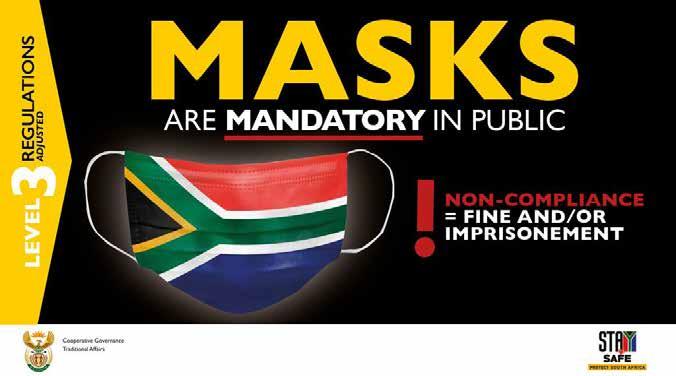
“When the pandemic first broke out there was tremendous fear and anxiety, particularly for us as communicators who would be called to the frontlines. This was something that we had never encountered before and we needed to get ready even though we did not know what would be expected from us. In those early days, we had to find our way and support one another in whichever way we could. I am proud of the many communicators who responded to the call in those uncertain times, often at their own personal safety.”
Ms Phumla Williams, GCIS DG

“Most of the time I felt a lot of anxiety and fatigue. I did not sleep well as I had journalists calling from 4am because they wanted to get their stories out by 5am. We were also on television (TV) and radio, which meant having to get up at 4am to be ready for the primetime news shows. We also spent a lot of time doing interviews in the evenings, which meant late nights. I was tired but at the same time I felt a huge sense of privilege to be that person communicating, being the nexus between the technical and communication.”
Dr Lwazi Manzi, then DoH Spokesperson“We had long days and long nights. As communicators, we were stretched to our limits so that we could keep South Africans abreast of developments to ensure that they had information so they could make informed decisions. I was glued to my laptop from one Zoom meeting to another to help coordinate government communication during this ex traordinary time. The traditional working hours that we were used to had gone out of the window. It was through the dedication of our entire team that we rose to the challenge in the fight against the pandemic.”

“During the first lockdown in March 2020, it was upon us at the GCIS to be on the forefront of communicating messages and informing the public about the COVID-19 pandemic. Per sonally, I had anxiety, stress and uncertainty of the future but as a public servant I had to be strong. We were exposed to the virus each time we had to be at work during countless media briefings, as we had to update the nation daily on the pandemic. We worked under extreme physical and psychological stress, and not only our health was at risk but we were at risk of exposing our families to the virus.”
 Mr Michael Currin, GCIS Deputy DG: Intergovernmental Coordination and Stakeholder Management
Mr Michael Currin, GCIS Deputy DG: Intergovernmental Coordination and Stakeholder Management
“When COVID-19 started, it started with numbers. When things hit a peak, the numbers changed to names. Now the names of people you knew and have interacting with such as the late Minister Jackson Mthembu. Some of us were working with him closely on a daily basis. When the numbers started to change to names, it began to get very scary and a moment that shook us as communicators.”

“As communicators we faced both mental and physical fatigue. Many communicators until today have not been able to take leave over the two years that we fought the spread of COVID-19. The call to national duty to provide information that would save lives and keep our citizens informed was victorious. We had pulled together as communicators and part ners in a common front to drive back the virus and protect our citizens.”
 Mr
Mr
“We were called on to craft messaging on something we knew very little about. We grabbed onto every bit of information we could find on the virus. Our messaging teams had to become experts overnight on the subject of viruses and simplify complex medical terms into easily understandable language. We were often called to work into the late evening so new information was available the following morning to keep citizens abreast of new developments in the fight against the pandemic.”
Mr Gill Price, GCIS Director: Communication Resource Centre
“I think for us we are so used to being in the frontline for a crisis. The media engagement team at the GCIS is always ready. While there was some initial concern over the virus, we configured ourselves to deal with this crisis. Mr William Baloyi was at the forefront coordi nating with the Ministers and the DG; a colleague was dedicated to updating our Twitter feed, another monitoring news and one in charge of quickly issuing statements. We had a working system that helped get us through the tough times.”
MsTshegofatso Modubu, GCIS Director: Domestic Media Engagement
“The place where we first activated the whole government communication machinery was when I was at a Justice, Crime Prevention and Security Cluster meeting. The meeting stopped for an important announcement. We were briefed on the situation in Wuhan, China and that if we did not act now we would face a crisis already experienced by other countries. We worked late nights as communicators; it was quite hectic as we dealt with a constantly changing environment. NATJOINTS also made lots of urgent demands on communicators.”
“What kept me going was the important work we were doing during those difficult times and seeing the number of partners that were part of the NCP growing and the impact our united front was having in the fight against COVID-19. I am grateful of the experience I have gained and the acquaintances made.”

 Mr David Jacobs, GCIS Chief Director: Cluster Communication
Mr David Jacobs, GCIS Chief Director: Cluster Communication
“The biggest challenge was the fact we had to educate people about the virus without being in direct contact with them. There was a time when we mulled over getting protective white over alls for all field officials and we had to stop in our tracks because of the stigma that was attached to these overalls. There was stigma in the communities against people who were infected. We had to work harder as provincial and local communicators to dispel these myths and educate our com munities about safe funeral practices as most people were getting infected at funerals. What worked for us was a strong provincial and lo cal network of communicators; we were able to use these platforms to spread messages that came from national government and the Provincial Command Council.”
Ms Ndala Mngadi, GCIS Director: KwaZulu-Natal Provincial Office
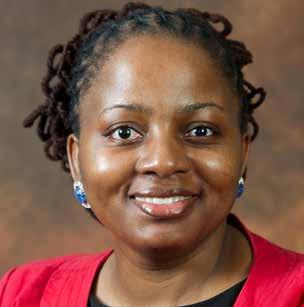
“The fear and restlessness triggered by the hard lockdown declared at that time meant government communications should take centre stage and put South Af ricans at ease. For me, that served as a testing moment for the effectiveness and resilience of communication coordinating forums of government at both pro vincial and local government. The team spirit displayed by communicators was very encouraging and the innovative ideas put forward – which included the use of strategic channels like loudhailing and community radio – mitigated against hearsays and fake news. Communities had an appetite to receive information on COVID-19. The vaccine roll-out programme also added a new flavour to the campaign when communities were encouraged to register for the vaccine. The on-site registration of approximately 2000 people on the Electronic Vaccination Data System (EVDS) through the GCIS-led community outreaches and the sub sequent vaccination services provided in partnership with the DoH, remain a ful filling contribution in the fight against the pandemic.”
Ms Moepeng Tshwane, GCIS Acting Chief Director: Provincial and Local Liaison (PLL)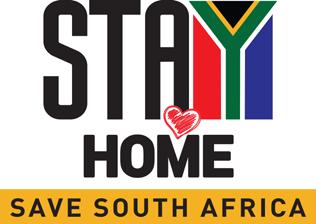
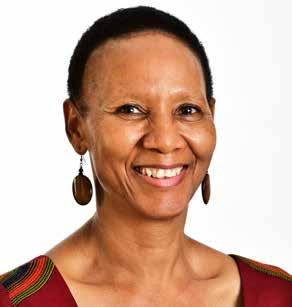
“There was a lot of anxiety, especially when the numbers were getting higher and names were becoming real to people we knew and family members – those infected, hospitalised or deceased. With the kind of work we do, that of reaching out to communities, we had to
change our tactics to still ensure that information was disseminated to communities whilst our officials were still safe. With PLL’s strong point being Development Communication, it was really hard as we could not do face-to-face engagements at some point and had to rely on community media, loudhailing and knock-and-drop activities to disseminate informa tion, which had an impact. One had to check on the team to ensure that they were safe.”
Ms Yolisa Blom, GCIS Director: Free State Provincial Office
“The realities of COVID-19 were felt when the country recorded more than 70 cases of the pandemic and the subsequent announcement of the hard lockdown in March 2020. The first question I asked myself was whether we would ever return to normal life. My anxiety was exacerbated by the growing number of positive cases and deaths related to COVID-19 in Europe. There were conflicting views about the pandemic, but government communica tors always gave our communities reliable and reassuring information.”
Mr Ofentse Moeti, GCIS Director: Northern Cape Provincial Office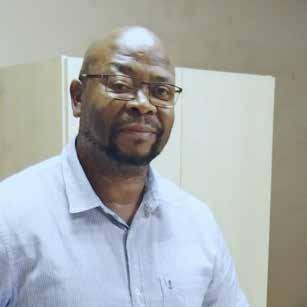
“When COVID-19 struck it was such an unprecedented occurrence. Being a Development Communication outlet in the GCIS, the shift from face-to-face to virtual interface was such a system shocker, but it was a shift for the better. A tactical shift that we unleashed was the power of digital communication, loudhailing and community broadcasting that was at the centre of intergovernmental communications messaging and coordination. Risky as it was at the time, we cherished the village-to-village and street-to-streets moments that we had in churning out government safety messages aimed at saving lives.”
“It was very challenging for me as COVID-19 was the biggest project that I ever worked on. We had to be at work every day during the height of the pandemic to ensure we communicated government’s messages to all South Africans. I personally felt at risk be cause you would be in contact with someone and then told they had tested positive for COVID-19. The Communication Service Agency (CSA) team members were also the ones on the ground going across the country to take videos and photos to cover our nation’s response.”

 Mr Ndlelantle Pinyana, GCIS Director: Eastern Cape Provincial Office
Mr Ndlelantle Pinyana, GCIS Director: Eastern Cape Provincial Office
“The pandemic destabilised the way we lived and communicated; I was scared because half of our population is not online. They are more familiar with word of mouth, which is why we have izimbizo and face-to-face communication. But the late Minister Mthembu ensured that communicators were here every day and people saw us speaking to them daily, which helped build hope in fighting the pandemic.”
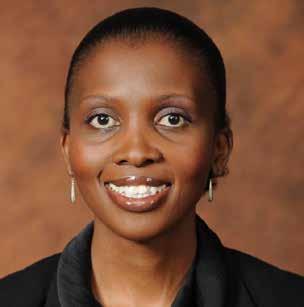
“I remember the research team having to search for any available research that could as sist to inform the Government Communication Strategy on COVID-19 pandemic urgently. None was readily available until we sourced and analysed the 2020 Edelman Trust Barom eter Special Report: Trust and COVID-19 as secondary data to use as a baseline research to urgently inform the strategy. Subsequently, the team conducted a unique tracking COV ID-19 research to inform changes to the strategy as government managed the pandemic and responded to the public information needs. Lockdown regulations required innovative and effective data collection methods to ensure timely availability of research insights.”

“Constant communication by government during the COVID-19 period instilled hope for citizens, and the well-orchestrated integrated communication strategy on mes saging made a meaningful impact by educating communities and raising awareness in multiple languages on the health and safety measures to protect livelihoods.”

“The GCIS rose to the occasion by handling an unprecedented number of requests for the multilingual translation of COVID-19-related communication products. Apart from trans lating communication products into all official languages, the GCIS Language Services unit also facilitated the translation of some information into French and Portuguese. In addition to providing editing and proofreading services, the Content Development unit also produced two online publications, Coronavirus Survival Guide and What you Need to Know about Coronavirus.


Many people in our country heeded the call to go over and above the call of duty in the fight against the COVID-19 pandemic. Government communicators also raised their hands to be counted.

Many of them worked frantically to produce and disseminate life-sav ing content. Like many essential services workers on the frontlines who often put their own health and safety on the line, the communi cators did likewise to keep vital information flowing.
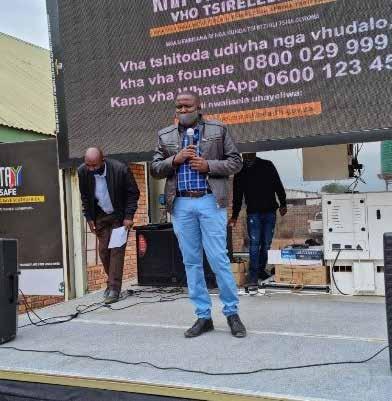


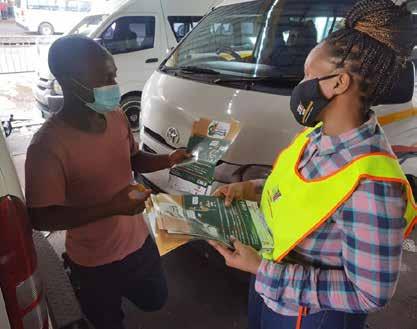
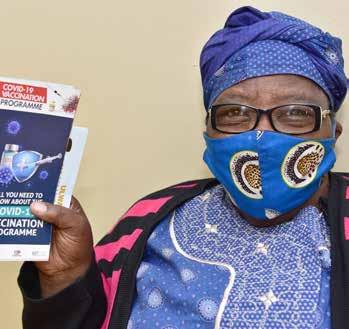


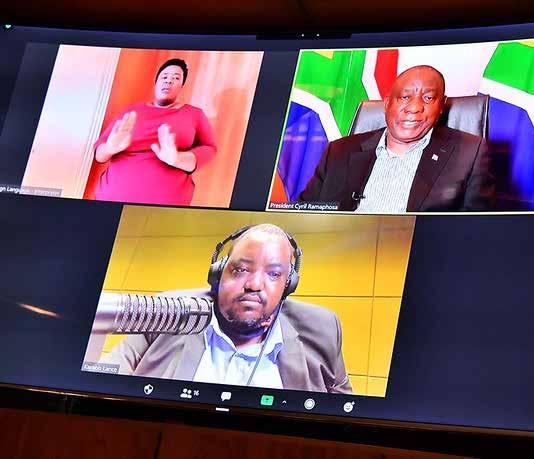


The first major communication by the DoH on COVID-19 was on two South Africans who were infected with the virus while aboard a ship in Japan. Communi cation at this juncture mainly focused on the issue of quarantine.
The situation worsened when South Af rican students studying in Wuhan, China, the epicentre of the COVID-19 epidemic, requested to return home. Preparations to repatriate citizens had begun and were accompanied by strong planning around communication.
In the initial days, communication be gan essentially in the “backroom” with key officials meeting every two days to plan for the repatriation of citizens from Wuhan. The meetings later evolved into a War Room.
There was intense media interest and apprehension among citizens on bringing
home South Africans from Wuhan, possi bility infected with COVID-19. Communi cation helped to keep the media abreast of developments and alleviate anxiety among citizens.

The country continued to remain on
high alert as reports of the unknown vi rus spread around the world. On 5 March 2020, the National Institute for Commu nicable Diseases (NICD) confirmed the country’s first case of COVID-19. The pa tient, a 38-year-old male, had returned
with his wife from a trip to Italy.
The couple and their two children were part of a group of 10 people who arrived back in South Africa on 1 March 2020. A media briefing was immediately con vened on the breaking news to keep the public abreast of the situation and limit any scope for speculation.
The couple’s children attended the Cowan House Preparatory School, which announced that it would close after con firmation that a parent had tested positive for the virus. The DoH met with school representatives and parents to provide them with information to help them make informed decisions in dealing with this sit uation.
The DoH developed the daily state ment. It initially contained few details and was later increased with additional con tent and graphs as the appetite for in formation became insatiable. When new
developments arose, more details were provided and the epidemiology then ex plained.
The DoH also established the weekly Friday briefing on COVID-19 on the Zoom platform with the Minister of Health and key experts from the country’s medical and scientific community. The regular en gagements ensured a constant sharing of vital information.

It was agreed that in line with interna tional practice, the President would lead communication on major announce ments and updates to the nation. The communication team at the DoH would then work with The Presidency’s commu nication team and the GCIS on major an nouncements.
It resulted in an approach that saw the President leading major announcements,
with Ministers thereafter communicating on what it meant for each department.

The drafting of the regulations was a daily exercise and communicators close ly collaborated with lawmakers. This al lowed communicators the opportunity to craft messages in a manner that made it easier for citizens to follow the regula tions.
One of the major shifts that happened with communication during COVID-19 was the use of Voice over Internet Pro tocol (VoIP). It allowed briefings, webinars and engagements to take place anywhere in the country to ensure a constant feed of information.

This form of online engagement was particularly valuable during the national lockdown when mobility was limited, and was a departure from the traditional faceto-face communication and big rallies typically used by government.
Broadcasters also had to learn how to
broadcast from the Zoom platform. In the beginning some broadcasters were film ing the Zoom meeting and had to learn to connect to VoIP onto their systems. There were many teething glitches such as people not hearing each other, learn ing to unmute and to put on their video. Eventually, Zoom briefings became the norm, which expanded government’s communication reach and opened the use of other online platforms such as Twitter Spaces, YouTube and live stream ing on Facebook.
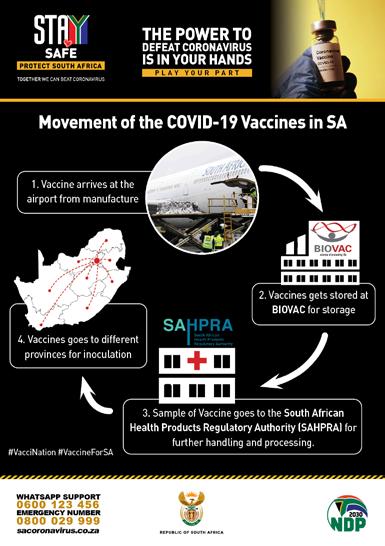

In late 2019, the GCIS together with the DoH developed a risk communi cation strategy to implement com munication measures to combat the COVID-19 virus. Once South Africa received its first reported case of COV ID-19, this communication initiative was widened to become an interdepartmen tal communication initiative driven by the GCIS.
The government communication ma chinery comprising national, provincial and local government communicators was activated. Given that the campaign had no dedicated budget, communica tion was implemented using existing plat forms and mediums of government com munication.
In the early stages, the overarching ob jective was to create awareness and ed ucate South Africans about the disease, symptoms and risks of infection. It includ
ed warning the public about the dangers of the virus, the provision of credible ad vice on symptoms, and providing infor mation on prevention and precautionary measures.
Importantly, the communication strate gy also focused on dispelling myths and misconceptions about the spread of the virus. It also targeted communication to stamp out fake news on social media.
The communication strategy central ised communication to ensure clarity, consistency and transparency. It was con tinuously updated to be relevant to the ever-changing circumstances.
A Crisis Communication Plan was in cluded to prepare for crisis communi cation when an epidemic was declared. In this instance, the DoH was the lead department and the GCIS was respon
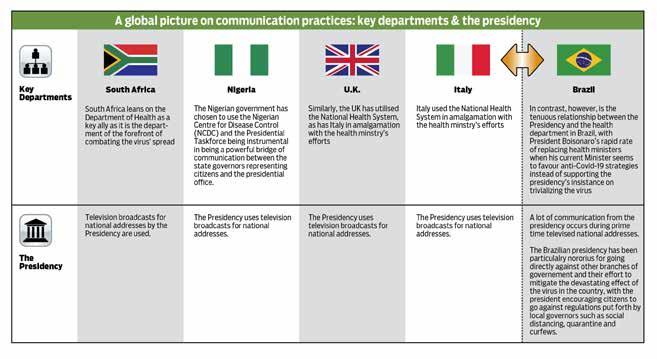
sible for convening the communication sub-committee around implementation of the communication plans to ensure in tegrated planning. It also involved media monitoring, and the drafting and dissemi nation of daily messaging to government for public communication, supported by continuous research to guide the impact of the message.
The table contextualises government’s communication efforts within global ef forts to rally against the pandemic. The South African Government’s communi cation methods were on par and even exceeded those used by other countries’ governments to fight the virus.

There was enhanced awareness of in dividual responsibility and of the severi ty of the threat posed by COVID-19. As a result, the public at large was constantly informed about the virus and ways to stay safe. Communication was also undertak
en to popularise economic and social re lief measures provided by government to protect lives and livelihoods. The graph above illustrates how communication was rolled out during the different nation al lockdown levels.
The arrival of life-saving vaccines on
our shores saw the launch of the coun try’s vaccination programme as a key in tervention to mitigate the public health and economic impact of the COVID-19 pandemic.
The vaccine roll-out programme – the biggest ever undertaken by our nation
– commenced in three phases to vacci nate a minimum of 67% of the population to achieve herd immunity. The roll-out ensured the majority of the population would be immune to the virus, indirectly protecting those who are not and making the spread easier to manage and contain.
The national roll-out was guided by a progressive vaccine communication strategy developed by the GCIS to com municate the vaccination programme.
The GCIS together with social partners – business, labour, civil society, media, traditional leaders, district communica tors and others – led the implementation of the communication strategy.
The multifaceted strategy covered all aspects of our nation’s vaccine roll-out and was driven at the highest level by the IMC on Vaccines chaired by the Deputy President.
The communication strategy was based
on scientific evidence, national research and extensive data analysis, which since the start of the pandemic, had dictated our nation’s approach to deal with the vi rus.
Our ground communication initiatives included, amongst others, door-to-door campaigns, activations to encourage vac cination, communication support to local

councillors, and content and infographic development.
This had empowered local councillors and community leaders to speak to their constituencies and help get the vaccine message across. Opinion makers, thought leaders, influencers and sport personali ties were engaged through various webi nars to support our communication push.

The COVID-19 pandemic re quired efficient government and society-wide communi cation. The GCIS brought to gether government communicators from all national government departments to ensure a coordinated and coherent com munication approach in the fight against the pandemic.
The department con vened the communication and community mobili sation work stream con sisting of government communicators. The work stream reported to the NATJOINTS and ultimately the NCCC under the lead
ership of President Ramaphosa. The DG of the GCIS attended the regu lar NCCC meetings and would thereafter brief communicators to align their com munication to the plans of government. Meetings with communicators were ini

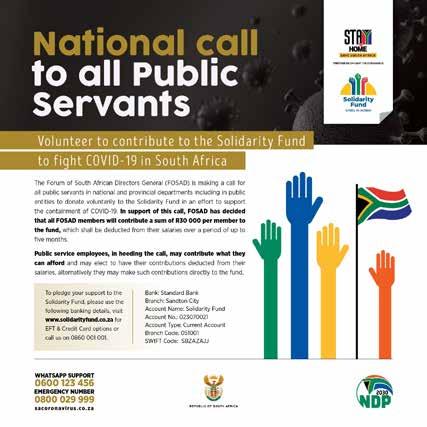
tially convened virtually as part of an Ops Room at 9:30am on weekdays to tackle issues in the media environment, inputs from various work streams, feedback from the NATJOINTS and focus on com munication planning. These meetings in cluded:
• The CCC: A daily meeting held on Zoom at the start of the pandemic. In the interest of improving coordination and allowing communicators time to plan and implement communication actions, the frequency of meetings was reduced to three times a week.
• Rapid Response meetings: Held daily to support the CCC, they includ ed regular communication strategis ing workshops. A similar approach was adapted at provincial and local levels.
• Communication Cluster’s meet-
ings: They were used to ensure all clusters aligned their programmes to the current COVID-19 situation. These engagements ensured that the cluster system dealt with transversal issues that required more detailed meetings than the CCC and Rapid Response. National communicators liaised with provincial, metro and district commu nicators through various appropriate forums to coordinate messages.
• Intergovernmental Communicators’ Forum: Convened every time there was a change in our commu nication approach, it allowed com municators to receive new directives and to deal with matters in their local environment. A reporting template with a standard set of indicators en
sured regular and detailed reporting on communication. These meetings were instrumental in building communication support around government plans to fight the virus. They became critical feedback mechanisms between national and provincial activities, especially when hotspots needed heavi er lockdowns than the rest of the coun try. It had also been at the forefront of identifying and stamping out fake news about COVID-19 often shared on social media, which caused panic and confusion among citizens.
All existing communication structures –such as the provincial, district, local gov ernment and municipal communicators’ forums – were also used to coordinate communication over the period.


Our communication approach was informed by local and international research related to the management of the pandemic. It allowed us to under stand the social and public health impli cations of the pandemic in order to man age communication.

Research findings offered guidance on strategies and policies for effective pre paredness and response efforts. These research findings from the GCIS’s Direc torate: Research allowed the department to adjust its communication strategy and respond to the communication needs of citizens.
The GCIS commissioned and used re search-tracking studies to measure the impact of government communication as a whole. For example, a partnership with the Solidarity Fund allowed the GCIS to conduct more focused research on the
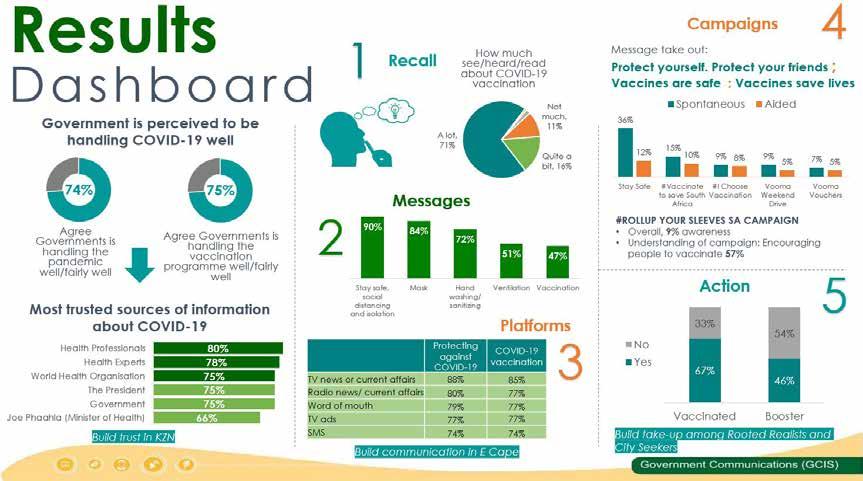
uptake of government messages on preventa tive measures as well as the vaccination pro gramme.
The research was instrumental in shaping how we crafted communication and met the information needs of our citizens. Research by Ask Afrika showed that the majority of South Africans across all segments of the population felt that government handled the COVID-19 pandemic well.
South Africans perceived government pos itively in the management of the COVID-19 pandemic (74%) and vaccination programme (75%). The main reason for the positive percep tion was due to government’s communication efforts, including educating citizens on how to stay safe. The positivity rate of the COVID-19 curve flattening and provision of social relief also influenced the positive sentiment.
Research showed that the majority of South Africans (90%) recalled messages about pro tecting oneself against COVID-19 through so

cial distancing; isolation and staying safe (Vaccinate and Save South Africa). The wearing of a mask (84%) and hand san itising (72%) were also amongst the top recalled messages, as part of our “Stay at Home” campaign.

The consistent messaging – as part of a collaboration between government and
social partners – resulted in awareness of COVID-19 vaccination communication improving drastically from 55% in 2021 to 87% in 2022. Research showed that the most recalled vaccination messages were protect yourself, protect your friend, followed by vaccines are safe and vac cines save lives.

Public perception about government’s
role in administering the vaccines had a significant increase from 66% in 2021 to 85% in 2022. This was linked to govern ment securing enough vaccines for all who wanted to be vaccinated and made sure vaccines were delivered to sites on time. The GCIS held webinars and online meetings to share research insights and findings.
The GCIS, through its media monitoring and analysis, al lowed government to stay on top of key issues arising in the environment. By tracking the trends and patterns of media coverage, government was able to refine its COVID-19 commu nication efforts.
The media analysis offered a reliable assessment of the media environment to ensure that government was cognisant of the challenges in the communication space. It also closely tracked how govern
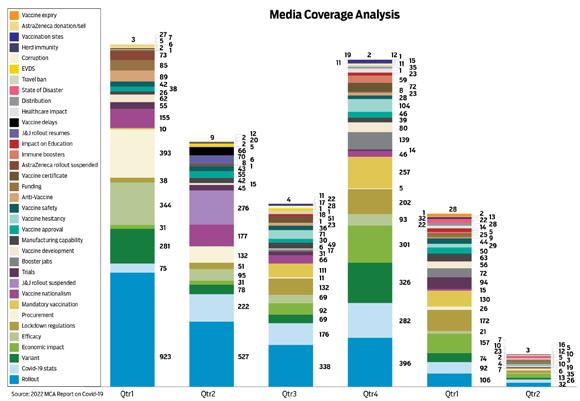
ment messaging was carried in the media in order to manage misrepresentation of government efforts.
More than 70 Media Coverage Analy sis (MCA) reports were produced weekly and quarterly. Media coverage of the var
ious addresses by President Ramaphosa, procurement of COVID-19 vaccines, the launch of the EVDS and finally the COV ID-19 vaccine roll-out were some of the prominent issues monitored and ana lysed.

Our endeavour to improve our com munication performance through benchmarking and evidence-based deci sion-making during COVID-19 saw the department piloting the innovative Gov ernment Communication Excellence Tool (G-CET) at the height of the pandemic. Developed by the GCIS, the new tool
monitored the communication efforts of 32 national departments between March 2020 and March 2022 for the attention of HoCs, DGs, NATJOINTS and the NCCC.
The G-CET data showed an exponen tial rise in government communication of close to 138 000 outputs from 32 nation al departments. The output reflected the
heightened crisis communication that the GCIS led by ensuring that content was co ordinated and further communicated to the public. The communication outputs averaged almost 6 000 per month over a 24-month period to bolster government’s fight against COVID-19. The graph below depicts the communication output from

government over the various phases of the pandemic.
Importantly, the G-CET also confirmed that government communication was diversified and integrated across a wide range of communication platforms as the GCIS sought to spread the message in the fight against COVID-19 to all South
Africans in all their various segments.
Uploading communication messages online in social media and departmental websites, which are accessed by millions of South Africans, resulted in the plat forms being the most used in govern ment communication.


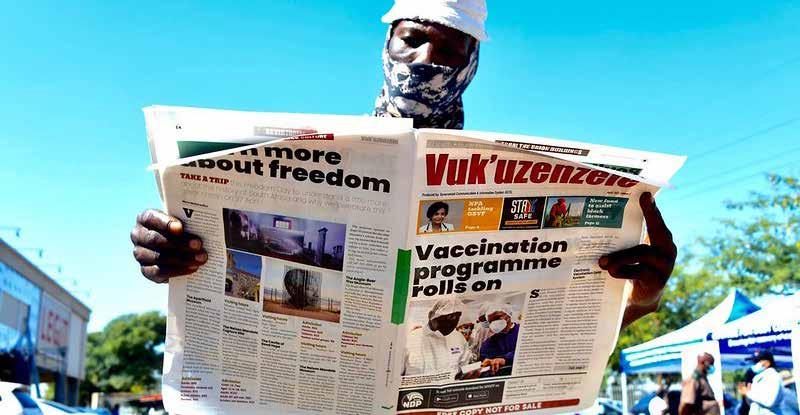
The GCIS embraced new ways of communicating with the public and used all platforms to extend the reach of the government message. Our communi cation messages, products and all infor mation about COVID-19 were distributed through campaigns, using all available channels and platforms.
Various platforms were used to ensure that our messages and communication resonated across a broader spectrum of the South African population.
Our work was guided by our unique GSM, which targeted the specific needs of each sector of our population and al lowed government to speak to each and every South African in a language or me dium they understand.
Our platforms traversed the diverse South African landscape; we reached citizens at the top end of the market
with innovative WhatsApp bots, while simultaneously ensuring those without media access were well informed. For example, the GCIS provincial offices, in partnership with other spheres of government and agencies, used loudhailing to communicate directly with some communities. Our picture of a communicator on
a donkey cart using a loudhailer to communicate the message to a rural community has by now become iconic
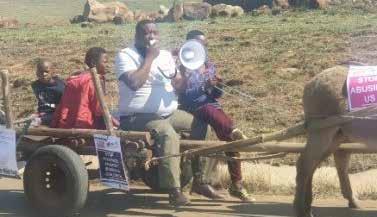
GCIS research showed that TV, radio and word of mouth were the key driv ers of COVID-19 message awareness.
SMSs, clinic posters, posters in shops or malls, nursing staff and social media were
amongst the top media platforms for the recall of messages. Media platforms for message recall of vaccination are the same as those of COVID-19 general mes sages.
Government set up a number of com munication outlets, including several hot lines and as well as a dedicated WhatsApp information service. The COVID-19 24hour Hotline: 0800 029 999 served as a valuable source to guide citizens with queries and assisted with emergency
support. The department in partnership with telecoms providers sent awareness messages to its customers through SMS and the Government WhatsApp number: 0600 123 456.
While a number of platforms were used, there was a strong shift to digital plat forms such as national portals, mobile apps and social media to accelerate the spread of information that reached South Africans with access to the internet.
During the start of the COVID-19 pan demic, the GCIS used online mediums to inform and educate South Africans on the virus, how it is spread and the necessary precautions to limit its spread.
South Africans could also get vital infor mation about the COVID-19 pandemic by visiting the website, www.sacoronavirus. co.za, which was zero-rated by major tel ecommunications companies to ensure free access. Hosted by the DoH, it pro

vided trusted and accurate information about the COVID-19 pandemic.
In support of www.sacoronavirus.co.za, the government website, www.gov.za, also hosted and collated all COVID-19-re lated information from the South African Government. The government website had become the first port of call for South Africans looking for information on the vi rus and government support.
To ensure ease of use, the homepage was redesigned to highlight COVID-19 content with an additional 47 content pages created to support content on the pandemic. Content on these pages included COVID-19 regulations (300), speeches (2 150) and statements.
From January 2020 to August 2021, the total page views were 128,2 million. The most popular content accessed on the site was the Social Relief of
Distress Grant; lockdown regulations and travel restrictions.
Social-media platforms – including the official Government Facebook, Twitter, YouTube and Instagram – played a crit ical role in disseminating information, while also providing room for engaging with the public to answer their questions and concerns. South Africans were also
able to watch live streams of press brief ings and announcements by government on the Government Facebook page. The GCIS collaborated with internation al technology and social media compa nies Google, Facebook and Twitter to promote official and accurate informa tion. Through the Google Search cam paign, user questions were directed to
the correct government websites contain ing the relevant information. Ad-grants re ceived from these companies were used to promote official and accurate informa tion through search campaigns.
Around R1,8 million in ad-grants had been received since April 2020.
Twitter donated R381 000 in ad-grants to the GCIS to boost COVID-19 and vaccine-related information on the platform.

US$5,5 million ad credits were received from Google for use in a search cam paign from May to December 2020.
Additional US$2 million was received in January 2021, which extended the campaign until the end of 2021.
The COVID-19 and Vaccine Aware ness Google Search campaign brought in US$6.2 million worth of traffic to the www.gov.za website, with a total of 59.2 million impressions and 14.3 million clicks.
Additionally, several other GCIS so cial media accounts helped increase the reach and impact of the messages to cit izens. These included the Vuk’uzenzele Facebook page, SA Government News Twitter and Facebook accounts, and GCIS Media Liaison Twitter account. Our suite of communication tactics also included the use of news outlets, com mercial media, community media and public service announcements (PSAs). News outlets were mainly used to com
municate daily updates on lockdown measures, changes in policy, government interventions and responses to rising in fections as well as measures being imple mented by the DoH.
The GCIS media partners provided val ue-added offerings through screens, bill boards and mall bathroom screens across the country. The department also negoti ated significant discounts with the various media owners, including the SABC.
TV was used to broadcast messages regarding strategic decisions, reminders and information regarding health facili ties, statistics and most notably lockdown procedures. Government also broadcast live most of the media briefings to com munity radio stations that reached farflung rural areas in the country.
Leaflets: More than three million leaflets from the DoH were distribut ed. Some 27 071 of these leaflets and
250 booklets were distributed by the GCIS provincial office during commu nity taxi rank and roadside activations, Thusong marketing programmes and community stakeholder liaison visits.

Remaining leaflets were shared with national departments such as the DoH (168 000), Cooperative Govern ance and Traditional Affairs (CoGTA) (2 400), Transport (48 000), Depart ment of Higher Education and Train ing (4 800), South African Police Ser vice (508 800), Department of Social Development (DSD) for the South Af rican Social Security Agency (SASSA) pay points (393 600) and South Afri can National Defence Force (134 400).
Online dissemination of infograph ics, media statements, radio scripts, recorded audio messages, announce ments and Ministerial video clips, GCIS Government News bulletin and My
District Today newsletter.
PSAs: Produced for radio and placed on SABC Public Broadcast Services stations with additional airtime on partner community radio stations. All PSAs were produced in 11 languag es. Over 9 000 PSAs were broadcast across these radio stations.
Community radio: Weekly shows coordinated by district communica
tors, community stations broadcast 10 to 15-minute weekly features. The GCIS undertook 41 community media engagements – 39 were radio pro grammes and two community TV.
District communicators: Some 27 district communicators from 22 non-governmental organisations (NGOs) were recruited in priority districts. District communicators were trained to communicate on public platforms and serve as reliable sourc
es of information within their com munities.
Community outreach: Nine (9) out reaches were undertaken. These in cluded support to The Presidency, Ministers, members of the Executive Council (MECs) and mayors.
Community activations: The GCIS undertook 34 community activations. These included taxi (12), roadside in tersections (11), malls and schools (11) and seven community dialogues.
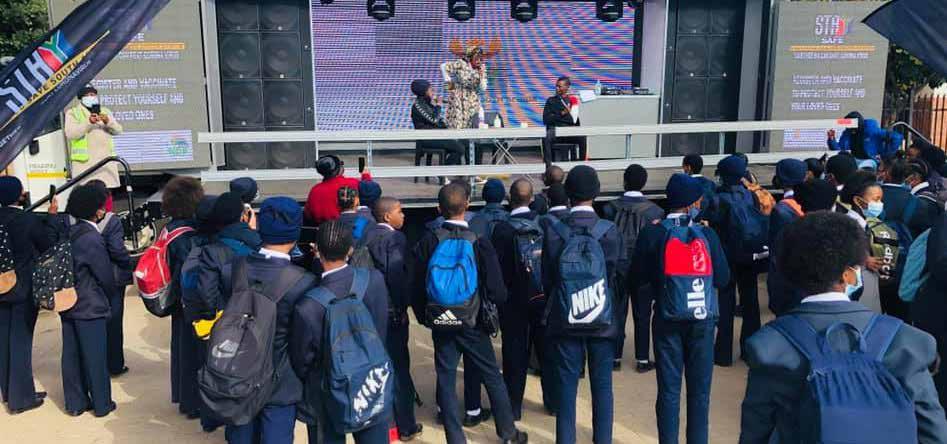
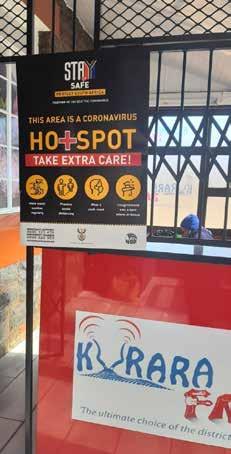
Effective public communication is the successful delivery of a message to a large group of people and where each indi vidual is impacted in such a manner that they are moved to action. At the heart of achieving this effective communication is honest, simple, coherent and targeted messages.
The GCIS messaging team was acti vated from the onset of the pandemic to ensure the information needs of citizens were met through targeted messaging that guided, empowered and reassured citizens. The messaging team drafted dai ly key messages, talking points and other supporting content.
The messaging set the tone for the nation’s fight against the spread of in fections by sharing the work of govern ment to prevent the spread of the virus. It continuously updated and educated South Africans on preventative measures
to reduce the spread of infection and en couraged responsible behaviour as re strictions were eased.
To ensure that our COVID-19 messag es resonated with the intended audience, the Government Segmentation Model
(GSM) – a model developed by GCIS to enable researchers and communicators to have a better understanding of South African citizens – was used to target the specific needs of each sector of our population and speak to each and every
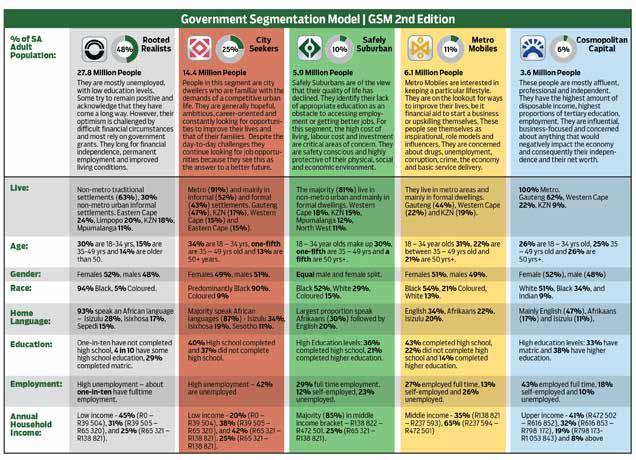
South African in a language or medium they understand. It enabled government to better engage with citizens on this important national issue, and to create greater alignment between citizens’ con cerns and messages.
At the heart of government’s messaging was to instil hope, confidence and draw South Africans into united action against a common enemy. Importantly, honest, concise and continuously updated gov ernment messages played a key role in
building public trust.
Key messages on COVID-19 were trans lated into all official languages and where possible, sign language interpreters were used for government media briefings and TV interviews. The GCIS Language Unit was at the forefront of making informa tion on COVID-19 timeously available in all official languages. It also facilitated trans lations into the two dominant Southern African Development Community (SADC) languages, Portuguese and French.
On 15 June 2022, the Pan South Afri can Language Board awarded the Mul tilingualism Award in the Government/ Public Sector category to the GCIS. The certificate and trophy were “for an effec tive service delivery campaign, project or programme in the public sector that seeks to promote multilingualism or any of the 11 official languages, including Khoi, Nama, San as well as South African Sign Language.”

The COVID-19 Infodemics Observatory Report of March 2020 ranked South Af rica second for the most reliable COV ID-19-related news and information. Re search showed that government was among the most trusted sources of infor mation for COVID-19 and the first port of call for South Africans seeking informa tion on the virus.
An important aspect on the messaging was educating South Africans on pre
ventative measures to empower them with information to fight against the spread of COVID-19. The preventative and safety measures heightened through government messaging played an impor tant role in helping limit the spread of the virus.
Messaging teams worked until late in the evenings to provide updated messag
es to government communicators follow ing the address by President Ramaphosa on the country’s response against COV ID-19.
After briefings by Cabinet Ministers to outline the President’s address, the mes saging was also updated to reflect the additional supporting content. The mes saging also played an important part in
simplifying complex regulations into an easy-to-understand format for citizens.
The GCIS Impact Assessment of Gov ernment Communication about COV ID-19 (April - May 2020) showed govern ment messaging was highly effective. As detailed in the graph, greater compliance among citizens was attributed to better access to messages.

Government messaging followed the various phases on the pandemic and the country’s response to the virus. During the vaccination phase, messaging focused on the new sense of hope abounding across our nation following the arrival of life-sav ing COVID-19 vaccines that strengthened our fight against the pandemic
To assist communicators to effectively communicate the country’s vaccine rollout programme, the GCIS had developed COVID-19 Vaccination Messaging Guide lines.

The communication skills in the various sections of the GCIS and the expanse of the govern ment communication system were used to support other departments and stakeholders in their communication efforts in the fight against COVID-19.
This often meant that GCIS staff had to go over and above the call of duty, work ing late into the evening and over week ends. Many of the department’s person nel had since the start of the pandemic not taken leave throughout the period in order to meet the demand for heightened communication.
For example, the GCIS Media Engage ment team played a supporting role in media briefings hosted by departments, various Ministers, clusters and The Pres idency. The GCIS had not only provided logistical support in preparing for the briefings but also strategic direction.
As the leader of government communica tion, the GCIS was drawn into the process to spearhead communication related to the repatriation of South African students and other citizens stranded in Wuhan, China.. At this point media enquiries were

overwhelming. Questions on how many people would be on board the plane, what would happen on the plane, along with where the repatriated people would be housed, were received.
To take control of the narrative and deal with the fearmongering, the GCIS
Media Engagement team announced the protocols to be followed, publicised health regulations and made known the strict procedures that would be initiated to safeguard patients and officials. This also included providing the official photos of the repatriation, facilitating me dia access to the Ranch Resort Hotel in
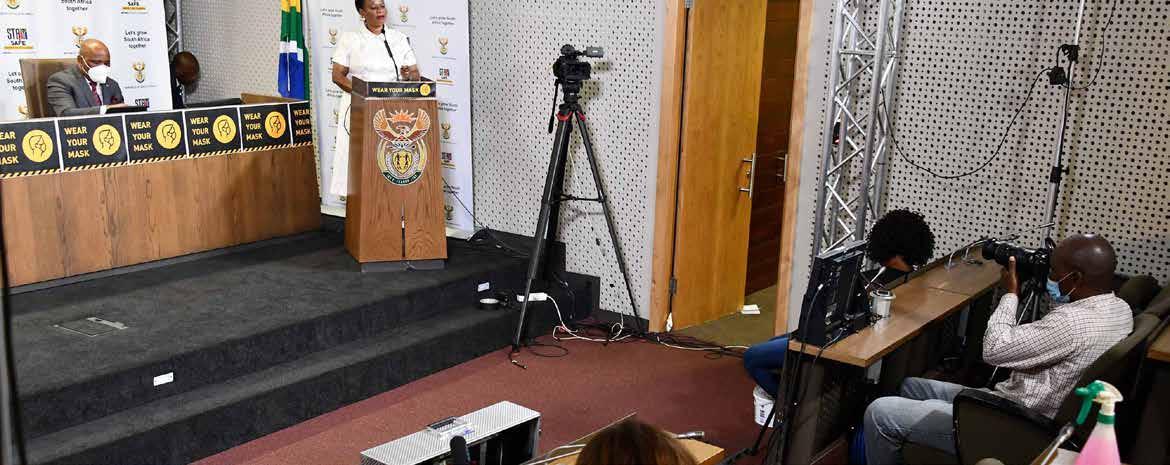
Limpopo where those repatriated would be quarantined, and positioning of media to record the arrival of the plane and the buses at the hotel.
The steady flow of information changed the narrative from panic to one of receiv ing our citizens who had families and loved ones waiting for them at home. In
formation sessions with the NICD were facilitated to brief the Limpopo provincial communicators and provincial executives where the students were to self-isolate. The repatriation of our citizens from Wu han showed that media at the time had limited information and understanding of the virus. Journalists had been search
ing for content and grasp of the medical technicalities of the mysterious virus.
One of the first endeavours of GCIS Me dia Engagement was to provide credible information to the media on the virus. A session was arranged between editors, health officials and medical experts on the nature of the disease. It resulted in a shift in reporting along medical lines.
At the height of the pandemic, GCIS Media Engagement coordinated with the South African National Editors’ Fo rum (SANEF) and the DoH on how media would operate within the lockdown reg ulations to carry out their duties to keep South Africans abreast of developments in the nation.
Steps were implemented to reduce the number of media in press briefings through a pool system and call-in tele phone lines for journalists. The unin tended consequence was that ordinary
citizens and dissidents would call into the briefings, which turned it into public meetings rather than assisting journalists in their work. Moreover, GCIS Media En gagement officials were also inundated with enquiries from the general public on their personal numbers.
The GCIS switched to the WhatsApp platform where journalists could pose questions online for briefings and receive updates. The WhatsApp group continued to serve as a platform for journalists who were not at a briefing to continue to pose questions.

Throughout the pandemic, GCIS Media Engagement was central in coordinating communication, interviews and PSAs. It hosted two briefings a day at the height of the pandemic, and recorded video and audio clips in different languages to be circulated.
GCIS Media Engagement Chief Director,
Mr William Baloyi, said: “We would liaise with the DoH and other stakeholders to
ensure we had updated informa tion for citizens. It was a continu ous mission and GCIS Media En gagement was at the forefront. When we would leave for the day, we would still continue to moni tor the situation from home.”
The media briefings were not only important for South Afri cans but to the SADC region as testing facilities in South Afri ca were used by neighbouring countries.

GCIS Media Engagement also played a central role in coordi nating government communi cation of the nine provinces.
While local, regional and in ternational media were the main partners, it also forged strong relationships with business forma tions, faith-based organisations (FBOs)
and civil society. Media statements, media invites and content were disseminated to these grouping for circulation among their members.
Partnerships with the broadcasters al lowed GCIS Media Engagement to roll out government briefings across the main radio and TV stations, including the 7am weekly Friday briefing by the DoH.
When vaccines arrived, GCIS Media En gagement worked together with SANEF and the DoH to ensure that journalists on the frontlines were a priority group.
The GCIS was responsible for the ad ministration process, including the verifi cation of journalists and loading them on the EVDS. Smaller associations such as the African Independent Publishers were also included.
The key lesson learnt through COVID-19 was the need for strong coordination, the need to adapt to any situation, be inno
vative and embrace different ways to en gage with the media. For example, webi nars such as the Africa Series launched by GCIS Media Engagement engaged with journalists, communicators, World
Health Organisation leaders and country officials on the continent. This allowed communicators in the country to tap into the communication expertise of communicators across Africa
who had first-hand knowledge of dealing with epidemics such as Ebola and Ma laria. Many African nations in their fight against epidemics were already familiar with vaccine communication and shared
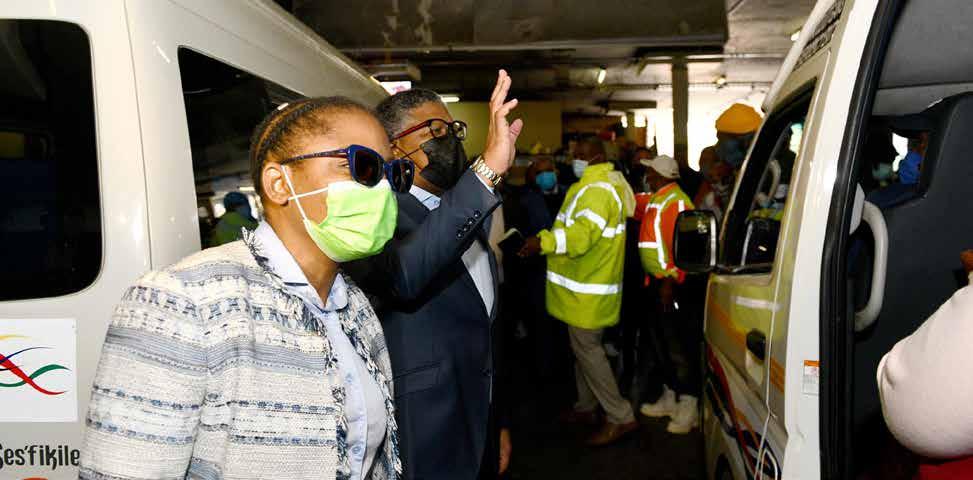
their insights which assisted communica tors in our nation’s vaccine roll-out.
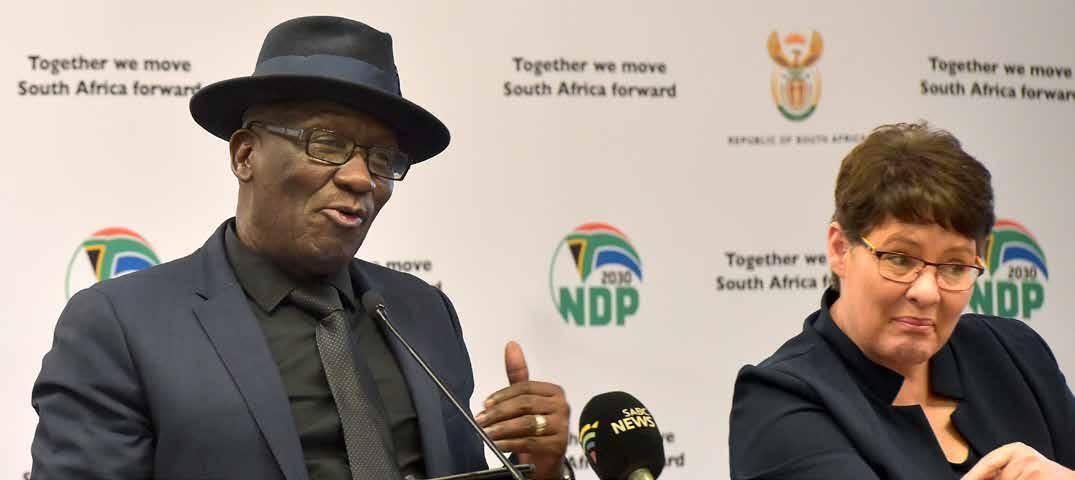
For GCIS Media Engagement, the COV ID-19 pandemic demonstrated that al though technology could enhance and simplify the work of media engagement
professionals, the basic principles of me dia engagement will always require inter personal relationships and consultation.
IMC ON VACCINES: When we finally managed to get the vaccines in the coun try, communication had to support the
process of getting people to get vacci nated. The vaccine roll-out programme was voluntary but critical in stamping the spread of new infections.
Communication had to deal with an av alanche of misinformation and fake news
of the effects of the vaccines. Chaired by the Deputy President, the IMC was con vened weekly to receive reports on the vaccination roll-out. A number of commu nication interventions had to be made to educate communities on the efficacy of the vaccines.
FAMILY MEETINGS: The COVID-19 pandemic introduced a new concept af fectionately termed by South Africans as the “Family Meeting” with President Ramaphosa. The President regularly up dated South Africans on COVID-19 reg ulations and the status of the country’s fight against COVID-19.
Through these engagements, the Pres ident led communication from the top, communicating strategic direction on government’s response to COVID-19. The “Family Meeting” address also set the tone on messaging. Following the
address, media reportage was more fo cused and detailed on the country’s fight against the pandemic.
The President’s update to the nation was followed by newly released alert levels and regulations by the Ministry of CoGTA, while various Cabinet Ministers also provided updates on their areas of influence.
These formed the focal point of com munication throughout the pandemic.
The GCIS played an important role in pre paring for the “Family Meeting” by provid ing logistical support for The Presidency. The morning following the address, the GCIS developed messaging on the key announcements by the President to help communicators further articulate and emphasise the pronouncements.
The regularity and frank nature of the engagements had fostered a sense of
family and solidarity. The “Family Meet ings” were crucial in ensuring that all peo ple knew the latest regulations and the rationale behind them.
They were also used to reassure South Africans that we were in this together and that we would prevail by standing as one. The frequent feedback to the country built high levels of trust, which was the bedrock of behaviour change. The frank ness that accompanied the address and taking citizens into confidence, inculcat ed a level of public trust and appreciation when things went right and understand ing when things went wrong.
Moreover, research had shown that that South Africans across all races and seg ments of the population trusted and sup ported President Ramaphosa to lead the nation during the pandemic.

In developing effective communi cation in the face of the pandemic, an important element was fostering partnerships with civil society organ isations, in particular those working on the ground to ensure that people are in formed.
The GCIS, together with the DoH, had taken this collaborative approach to communication because we knew our success in defeating the virus lay in each one of us doing our part.
While the forging of partnerships was a key factor in the fight against COVID-19 and saving lives, the very first stakeholder meeting held at the GCIS Head Office was attended by a number representatives from businesses and companies. They were in search of urgent information on the virus and how their businesses should respond. It highlighted the critical need to

bring all stakeholders together in a united front.
The extent of available COVID-19 con tent had placed government in a unique position to become the source of reliable and credible information to our partners. It was agreed with all partners that gov ernment would provide them with rele vant and verified information to expand on their various platforms and through their communication channels.
The GCIS and DoH crafted COVID-19 content such as infographics and mes saging for partners. While this communi cation initiative was led by government, its success hinged on the support of the partners.

The partnerships assisted in the quick adoption of measures to prevent need less exposure to the virus. Our stakehold ers would also become powerful agents
to inform people about the risks of the virus.
The GCIS brought together business, la bour, and civil society under the auspices of the NCP on COVID-19 and vaccine rollout in January 2021. The NCP was respon sible for managing communication activ ities between the private, public sectors, civil society and organised labour on the

response to COVID-19 and the vaccine roll-out.
The department convened the partner ship weekly to plan and execute the vac cination communication. Since the start of the partnership in 2021, the GCIS con vened close to 50 weekly meeting until ended in mid-2022.s As part on the NCP, a Civil Society War Room was established to create commu nication products, provide ad vice, share relevant information around the vaccine roll-out and maximise communication to various constituencies, particu larly through community-based outreaches.
In one instance, the NCP was faced with the issue that despite mass communication on the avail ability of vaccines, people were still not coming forward to be vaccinat
ed. After deliberations within the NCP, it was recommended that communication must focus at speaking to people one on one in their communities.
Young doctors were roped into commu nities to explain how vaccination works. They also addressed some of the myths on vaccines to help convince people.
Through the NCP, various regional ac tivities were coordinated to maximise the impact of each event by sharing resourc es and drawing local media attention to these collaborative events.
NCP members were involved in a num ber of activities, including stakeholder engagement to influence and encourage their constituencies to stay safe, practice non-pharmaceutical interventions and to vaccinate.

“We forged these partnerships on the premise that each partner would run with their own campaigns. We wanted a mul
titude of campaigns to help reach more South Africans and get the message across, and it worked,” said GCIS Policy and Research Chief Director, Ms Tas neem Carrim. Government and civil-society partners participating in the War Room imple mented a total of 1 011 activities over the period of the partnership. There was also training the trainer to capacitate com munity members with more information about the virus.
The GCIS mobilised resources within the government communication system to further the work of our partnerships. Through its coordination of intergovern mental communication, the department was quickly able to reach all parts of our country, particularly communities at local level through various forums, platforms and stakeholders across the government communication system.
There were a number of partners who embraced the call from across civil socie ty, volunteer groupings, NGOs, FBOs and business. For example, religious forma tions such as the South African Council of Churches (SACC) spearheaded the Vax uMzansi Campaign and Train-the-Trainer workshops that advanced vaccine litera cy.
The Solidarity Fund provided funding for community-outreach campaigns and of fered paid-for advertising to disseminate messages. It also funded communication research projects.
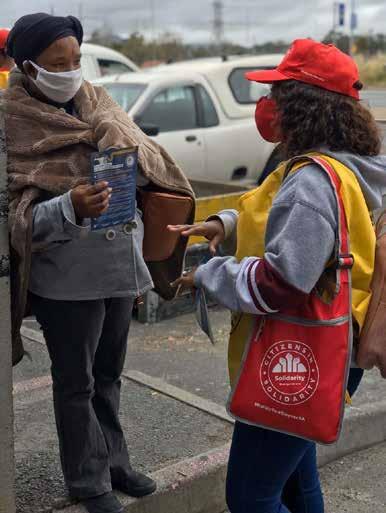
In partnership with NEDLAC and the Solidarity Fund, the Vaccination4Men was hosted to look into the reasons why South Africa had a slow uptake of men getting vaccinated. The Community Constituency Front (CCF) assisted with compiling the Traditional Healers and Leaders’ Guide/ Manual and People’s Vaccine Campaign
of South Africa (PVC-SA) training of com munity leaders to empower their constit uencies.
Business for South Africa (B4SA), the Congress of South African Trade Unions (COSATU), the mining industry and FBOs assisted with content and message dis semination using their own platforms.
CovidComms, a network of volunteer communication professionals, used con tent provided by the department and oth er stakeholders to package it in formats that were easy to distribute across plat forms like WhatsApp and Facebook. The team at CovidComms was instrumental in the design of animation and infographics to drive the COVID-19 message.
The GCIS, together with several govern ment departments, CovidComms, NGOs, the Red Cross, United Nations Children's Fund and the Real411 came together in the Risk Communication and Communi
Group to deal with misinformation and disinformation. There were weekly social listening meetings that discussed devel oping trends and possible issues that may arise.
The reports presented at these meet
ings pointed to a need to provide com munication on vaccine safety. The GCIS together with the South African Health Products Regulatory Authority, NICD and the DoH formed a Vaccine Safety Com munication Task Team to address issues emerging around vaccine production, procurement and administration. Webi

nars and expert interviews were arranged and recommendations were made to the Minister of Health to include particular ex perts in his Friday briefings.
The GCIS partnership with the media fraternity played an important role in dis seminating information and educating South Africans on vaccinations. Many me
dia houses carried government’s messag es, content and infographics across their platforms and pages for free. Through this partnership, government increased public awareness on vaccination and as sisted the journalists at the coalface of reporting to be vaccinated.
Provinces, traditional leaders and churches did considerable work in ex tending the government content. The Na tional House of Traditional and Khoi-San Leaders were part of efforts to reach all sectors of society and were encouraged to spread the word about COVID-19 pre vention and get the COVID-19 vaccines with their constituencies.
Engagements were also held with the SACC and Demand Acceleration Task Team (DATT) Dialogues. The GCIS held 11 roundtable dialogues in seven districts with 50 religious leaders and youth lead ers in attendance. Through the SANTACO
KwaZulu-Natal Conference, more than 300 participants including a representative from the Royal House, were engaged to encourage citizens to vaccinate.
The GCIS also engaged with third-party en dorsers such as experts and prominent per sonalities to promote government messages.
In a move to reach South Africans over 60 years to be vaccinated, the South African Med ical Research Council identified social-grant queues. It began working with SASSA, the DSD and the DoH to take the vaccine directly to people in grant queues. However, there was no protocol for vaccination in queues and this had to first be developed.
The initiative resulted in a strong public-pri vate partnership with supermarkets chain stores such as Boxer, Pick n Pay, Spar, Shoprite and Massmart stores where people collected their social grants. These partners made their stores available and together with clinical op erators funded by the Solidary Fund, they were

used for pop- up vaccine sites.
By taking vaccines to where people lived, a million people were vaccinated in nine months. Together with telecoms op erators SMSs were sent to people within a 15-km radius of the pop-up vaccine site encouraging them to be part of the na tion’s vaccination drive.
Partners to the NCP used the following activations to profile the country’s vacci nation drive.
Vooma Vaccination Weekends –Vooma Vaccination Weekends mo bilised South Africans and help ac celerate demand for vaccination. Led at a Presidential level, these were im plemented in 3 phases: Vooma 1: 1-3 October 2021; Vooma 2: 12-14 Novem ber 2021 and Vooma 3: 2-4 December 2021.
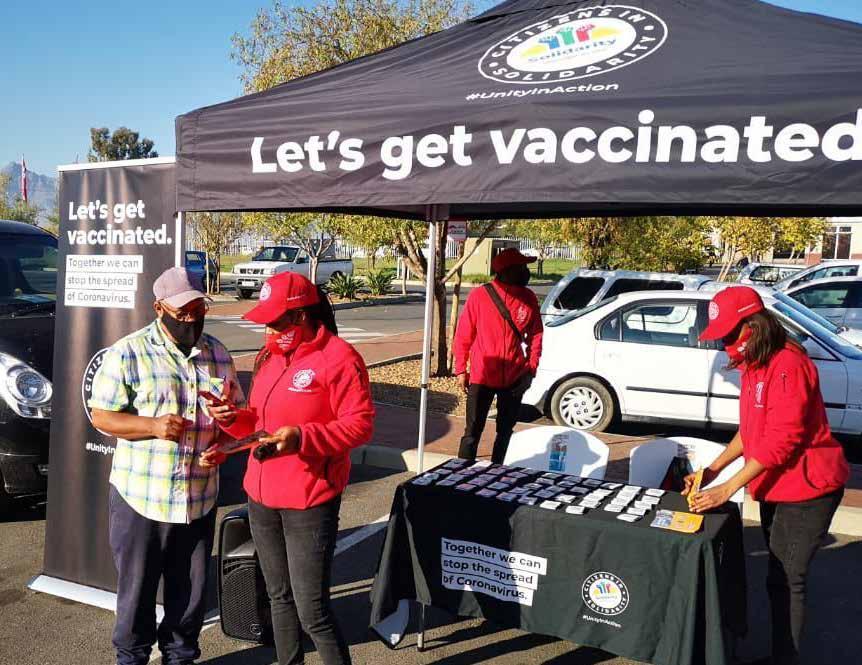
Vooma Transport – SA Taxi provid ed eight 26-seater buses for transport
as part of the Vooma Transport Trial.
Passengers were from the youth and 60+ cohort in Gauteng.
VaxuMzansi Campaign – VaxuMzan si was presented to SACC member
churches and networks’ meetings. The SACC played an active role in promoting the vaccine uptake with the aim of vaccinating at least 70% of congregations.
Kouga District, in the Eastern Cape.
–
Vaccine Literacy and Mobilisation was held in November 2021 and includ ed SACC member venues across the country.
–
Events were held across the country such as dialogues in Kwa-Nomzamo,

Vax Champs – This campaign was aimed at inviting everyone to be an ambassador for vaccination. Launched on 12 November 2021, it aimed to educate people about vac cines and encourage them to pro mote vaccination to others. Over 34 000 people registered as Vax Champs as the campaign ran on so cial media accounts on Facebook, Twitter, Instagram, TikTok and Snapchat. Vaccination4Men – A hybrid event held on 6 November 2021 in partner ship with NEDLAC and the Solidar ity Fund. The event looked into the reasons why South Africa has a slow uptake of men getting vaccinated, as well as explore the conversations needed to encourage vaccination
uptake. About 30 men attended the physical event. Traditional Healers and Leaders’ Guide/Manual – The CCF assisted with compiling the guide/manual, which provides key messages and facts on vaccines.
–
KeReady Campaign by the DATT tar geted vaccination among young peo ple (18-34 year olds) media coverage for the #KeReady reached 4 581 304 online and 40 781 156 through broad cast. PVC-SA – Training of community leaders to empower their constituen cy resulted in 33 Train-the-Trainer ses sions, 739 trainers trained, 362 vaccine literacy workshops held and a total of 8 222 community members trained. TikTok campaign – Discovery
Health used social media to drive the vaccination message to younger co horts and dispel the myths about vac cinations using influencers.
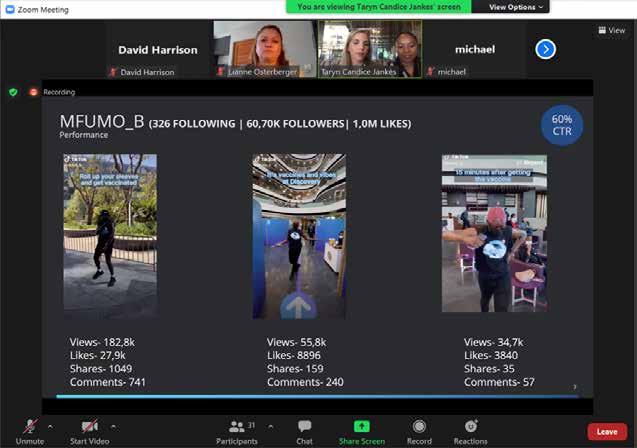
Mining industry and faith-based conversations – Government, B4SA, mining industry and FBOs met on the vaccination roll-out process as a structure for reflection.
Solidarity Fund – Campaigns includ ed “Don’t be a Mampara”; “When we Come Together” RollUpYourSleeves, CCF for the Vaccination of Men Cam paign., CovidComms (two projects), C19 (one project) and SACC (two pro jects).
COSATU
Vaccination Drive: It rallied workers to participate in the nation’s vaccination drive.
Religious Forum against COVID-19: Played an active role in pro
moting the vaccine with the aim of vaccinating at least 70% of congrega tions. Participating religions included Hindu, Muslim, Judaism and Christian. Also soccer fans – The Department of Sport, Arts and Culture and South
African Football Association initiative, and schools vaccination programme by the Department of Basic Education.
“The GCIS played an important role in acknowledging there would be different players and helping facilitate the different players.”
– Ms Jane Simmonds, South African Medical Research Council


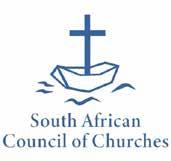


“The GCIS was central to the coordi nation of COVID-19 messaging, bringing coherence during a time of national cri sis, and also played a vital role in bringing communicators from all four social part ners together in the NCP; a unique com munications social compact.”
– Mr Chris Vick, CovidComms.
“To deliver a national vaccination pro gramme we needed government, busi ness, labour and a broad spectrum of civil-society organisations to share re sources and quickly cascade credible in formation to our constituencies and the public. So, working with the GCIS and oth ers we created the NCP as the primary forum for communications and vaccina tion campaign collaboration.” – Mr Timothy Schultz, Lead: Communications, Stakeholder and Advocacy, B4SA.
“We walked and worked with the GCIS to ensure that we all sang the same COV ID-19 hymn book. The commitment to collaborate and cooperate through the platform of the NCP between govern ment, business, labour and community stakeholders was sustained because the GCIS was the glue that held us tightly together. The GCIS was an artistic con
ductor that made all of us sing like a perfect choir using our different voices to sing one COVID-19 song. As the CCF our voice and our contribution count ed.” – Mr Mabalane Mfundisi, CCF Convener
“The NCP is living proof that we are stronger and better together. Many of us could not have achieved our goals at the extent we did without this platform.
It was a world where business, govern ment, civil society, and faith networks shared their resources, collaborated together and strengthened each other without any expectation of return. We just wanted to see each other win! I am grateful for the experience and the re lationships built. This platform renewed my hope that the South Africa We Pray For is possible.” – Ms Mathume Masha, SACC HoC and Programmes.
“I joined the NCP initially as one of the participants from B4SA, where I was as signed by Anglo American as a Project Manager − our role went beyond min ute-taking to supporting a cohesive spirit within the team, assigning and ensuring that resolutions taken were implemented, connecting members on tasks to ensure a collaborative teamwork, and securing speakers and people to chair whenev er there was a need. I can safely say the NCP was like a maestro that managed to successfully assemble unfamiliar voices on the spur of the moment from govern ment, civil society and business spheres at a dark time in our history when we des perately needed a unified voice to keep our people informed, responsive, respon sible and hopeful. I am grateful I was part of the NCP and for the people I got to meet.” – Ms
Nomalizo Xabana, B4SA Project Manager






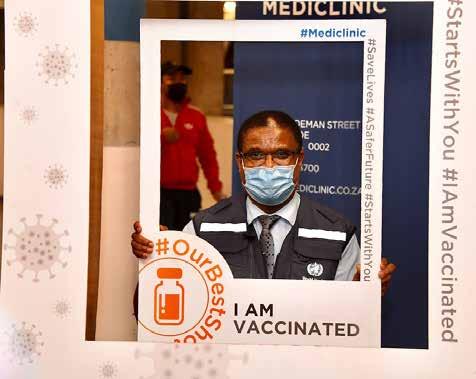





The pandemic changed us all.
People are now much more comfortable with the idea of interacting with government online. This placed a massive responsibil ity on the GCIS to be the conduit that al lowed open interaction with government. The GCIS aligned its operational plans

to ensure that it spoke to the dai ly realities of the pandemic. The department relied more heavily on social media and cloud-based technologies to disseminate infor mation for public consumption.
GCIS web servers were allocat ed additional bandwidth to ac
commodate the increase in internet traf fic to the department’s websites caused by citizens seeking government informa tion during the pandemic.

This meant that GCIS staff had to quick ly adapt to the new reality of online and remote working. Communicators were called on to continue to work from home and had to navigate around the new technology to ensure the work of the de partment continued unabated.
A migration to the State Information
Technology Agency Virtual Private Net work remote access (VPNra) connectiv ity tool allowed staff to work remotely and access the internal GCIS enterprise systems and automated processes. Ad ditional bandwidth and data were made available for staff to work remotely and ensure business continuity.
Staff who did not have GCIS-provided
connectivity were provided with workfrom-home Wi-Fi allowances to enable them to work remotely with their home WIFI as soon as possible to avert the de lays in sourcing additional GCIS remote connectivity.
The department had also prioritised the upskilling of its workforce through train ing initiatives aligned to the occupational
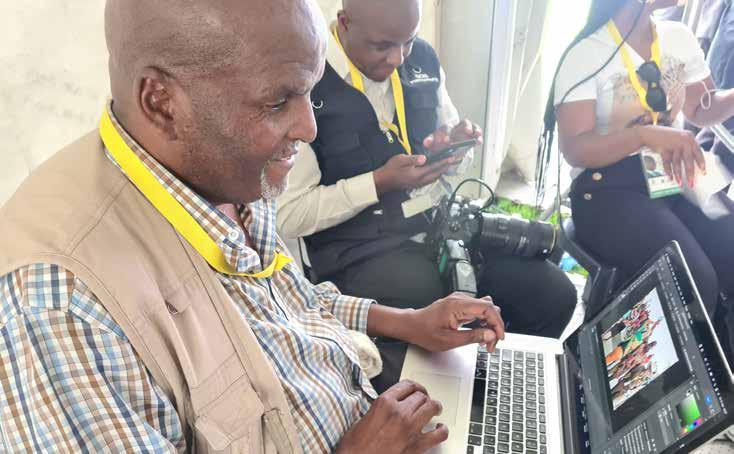
demands associated with the Fourth In dustrial Revolution to address Hard-to-Fill Skills related to the GCIS’s core functions.
It accelerated the adoption and in creased the use of online learning. The department embraced e-Learning plat forms and encouraged employees to reg ister for online courses.
The new environment also propelled the GCIS to quickly transition its physical corporate channels to the digital space.
For example, the department automated its memo-approval processes through its e-memo system. The new innovation allowed the department to continue in its work to service the communication needs of South Africans. Meeting packs and documents were accessed electron ically through the VPNra from the GCIS Enterprise Content Management System.
The GCIS Employee Health and Well
ness unit updated and supported GCIS staff members psychosocial ly on issues related to the pandemic. The unit assist ed employees to be pro tected from chronic stress and poor mental health during the pandemic. Staff members who tested positive for COVID-19 received tele phonic psychosocial and well ness support services during their recovery.
The GCIS reviewed and refined its miti gating strategies and plans to ensure that it addressed any potential risks as they were identified to stop the spread of the COVID-19 virus. Staff were encouraged to continue taking precautions to safeguard themselves, use available technology and

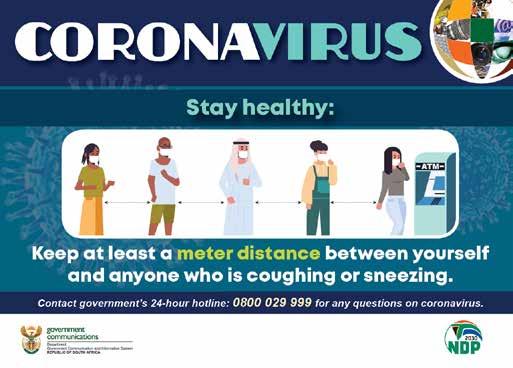
avoid physical gatherings.
The department has been widely applauded for its ver satility to ensure business continuity during the var ious levels of the national lockdown.
During the COVID-19 pandemic, many false or misleading stories circulated on social media about the virus, which created unnecessary panic.
The GCIS had become the vanguard in protecting citizens from the rampant spread of fake news.

One approach against misinformation was achieved by explaining misleading or manipulative ar gumentation strategies to people. It includes a warning that people may be misled, followed by a pre-emptive refutation of the misleading argument
Communication called on everyone to think twice before simply sharing or reposting content received. We impressed on citizens their duty to act responsibly and in the interest of society as there was no place for news or social media content that promoted hate speech, anarchy and chaos or infringed on the dignity of others.
South Africans were encouraged to ask critical questions and consult widely available resources to verify information. It included a simple Google search on a topic or occurrence which quickly revealed if the infor mation shared was fake or false. Similarly, a reverse image search on Google will reveal if a picture has been used before.
The GCIS profiled resources such as https://africacheck.org/, which contained a wealth of information on spotting fake news and What’s crap on WhatsApp https://www.whatscrap.africa/which helped identify and report fake or false information shared on WhatsApp.
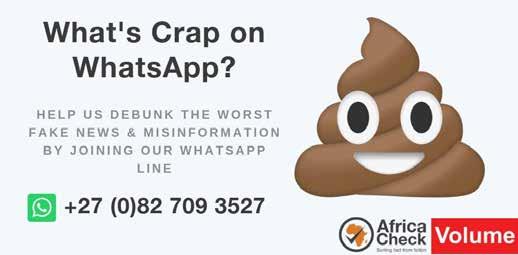
The official government website, www. gov.za, was identified as the one-stop portal for news and information, and had a wealth of additional resources. The Real 411 https://www.real411.org/ was promot ed as a resource where citizens could re port digital offences such as disinforma tion, hate speech, incitement to violence and journalist harassment.
The was also sensitive to the fact that every time misinformation was ad dressed, someone else’s agenda was pro filed. Before spending time and resources on addressing specific misinformation, it is also important to know whether it is re
ally having an impact or is likely to have an impact.
The GCIS adopted an early warning system that included monitoring key accounts that enabled the early identifi cation of fake or misleading news. The department collaborated with external departments and partners through the RCCE Social Listening Group to deal with mis-and disinformation. Weekly social listening meetings discussing developing
Th department also worked with social media companies such as Facebook and Twitter to identify fake accounts of de partments and Ministers. These together with posts on fake information were re ported to the platform owners for remov al. On Twitter, keywords and phrases were set that would send links and answers to fake/misinformed tweets.
South Africa – The 2020 Special Adjust ement Budget resulted in an additional allocation of R60 million for the GCIS. This enabled the department to drive the COVID-19 Communication Strategy in a more meaningful and effective manner. The country’s communication spend was support by the Solidarity Fund cam paigns which accounted R119 million. The
Citizens in Solidarity campaign was imple mented from March to December 2020 and was a national, multi-pronged com munication initiative that educated South Africans to come together and practice behaviours to help to manage the pan demic.
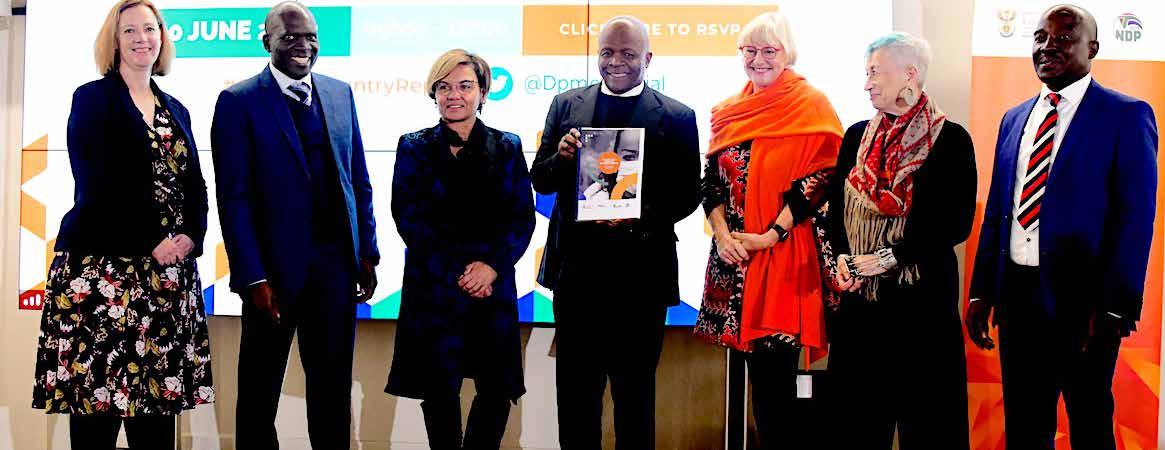
United Kingdom (UK) – The UK Gov ernment invested over £184m on commu
nications relating to COVID-19 in 2020.
• £171.9m was spent on media activity.
• £12.2m was spent on COVID-19 adver tising.
• UK GDP for 2020: 2.04 trillion pounds (2.708 trillion USD (2020)).
• GDP per capita: 40,284.64 USD (2020) – Google from World Bank.
• Population: 67.22 million (2020).
The government of the UK’s total man aged expenditure as a share of gross do mestic product was 51.6% in 2020/21.
‘Social Protection’ and ‘Health’ together account for more than half of all of central government’s own expenditure on servic es. In 2021/22 spending on social protec tion increased to £243.5 billion compared to £242.8 billion in the previous year.
Australia – The Australian Government spent A$23.9 million on its 2021 COVID-19 vaccination information campaign.
• Australia’s GDP for 2020: 1,327.84 bil lion US dollars.
• GDP per capita: 51,812.15 USD (2020) (Google from World Bank).

• Population: 25.69 million (2020).
New Zealand – The government spent nearly US$21 million on COVID-19 ad vertising as of 30 June 2020. The adver tising cost, which included ads on TV, radio, newspapers (print and online), so
cial media, bus stops and billboards, was US$18.3m.
• New Zealand GDP for 2020: 212.5 bil lion.
• USD (2020) (Google from World Bank).
• GDP per capita: 41,791.79 USD (2020).
• Population: 5.084 million (2020). Core Crown expenditure was US$5.2 bil lion lower than forecast at US$114.0 bil lion. The COVID Response and Recovery Fund (CRRF) was also created during the 2019/20 year. At 30 June, US$26.0 billion had been allocated from the CRRF to support the early COVID-19 response. The three largest areas of total Crown expenditure for the 2019/20 financial year were:

• Social security and welfare: US$49.9 billion
• Health: US$20.5 billion
• Education: US$17.6 billion
Wales – Total cost of all advert and
asset production, media buying, public relations, stakeholder and public engage ment for the Keep Wales Safe (COVID-19 public information) campaign and Test Trace Protect (COVID-19 testing) cam paign.These costs exclude VAT.
• 2020-21: £3,985,446.67.
• 2021-22: £6,815,802.10.
• Wales GDP for 2020: 75.7 billion British pounds.
• GDP per capita: 23,882 British pounds.
• Population: 3.17 million (2020).
United States of America – In the summer of 2020, the US Department of Health and Human Services began a US$265-million campaign to promote COVID-19 prevention and encourage vac cine acceptance.
• USA GDP for 2020: 20.94 trillion USD (2020) (Google from World Bank).
• GDP per capita: 63,543.58 USD (2020).
• Population: 329.5 million (2020).
In fiscal year (Financial Year) 2021, the government spent US$6.8 trillion.
Mandatory spending by the federal gov ernment totaled US$4.6 trillion in 2020, of which US$1.9 trillion was for Social Se curity and Medicare.
Mandatory outlays by the federal gov ernment totaled US$4.8 trillion in 2021, of which US$1.8 trillion was for Social Secu rity and Medicare.

While social media was used to spur commu nication at the onset of COVID-19, research continued to point to broadcast media as be ing the preferred platform by citizens to receive information.
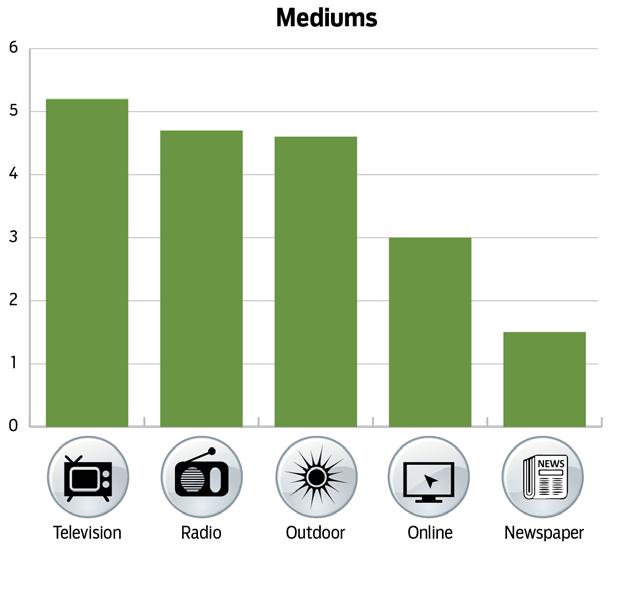
The GCIS ensured that communication on COVID-19 was supported by a mix of commu nication platforms. An integrated media cam paign was implemented using TV, radio, social media and out-of-home advertising such as billboards, screens and wall murals. The graph shows the spread of platforms used by GCIS in the campaign.
The key thrust of the advertising campaigns was to mobilise South Africans to continue the fight against COVID-19 by promoting con tinued adherence to the non-pharmaceutical health measures. It also advanced the vaccine roll-out campaign to encourage more citizens to vaccinate. Moreover, as restrictions were relaxed, the message of “StaySafe to Protect South Africa” was communicated.
Through the GCIS Media Buying unit, the department aimed to reach people in their different spaces. With most people at home during the start of the pandemic, radio, TV and social media were used to educate and meet the information needs of citizens.
Messages on decisions, reminders and information regarding health facilities, statistics and lockdown procedures were widely broadcast. Radio and TV stations in both commercial and community media were used to flight adverts, news clocks and squeeze-backs during the period.
The GCIS Media Buying unit was allo cated R60 million to implement the COV ID-19 campaign from April 2020 to Jan uary 2021. The chart indicates the total spend on each media type.

To effectively educate and empower all 60 million citizens in the fight against the pandemic, a budget of more than
double the allocation would have been required. To stretch the budget to reach all South Africans, the GCIS Media Buying unit forged partnerships and collaborat ed with media owners to effect the cam paign within the allocated budget.
GCIS CSA Chief Director, Ms Neli Shup ing, said: “The project was much bigger than us so we needed support from our external stakeholders. When I negotiated with media owners on this campaign, I said that it was the responsibility of each
and everyone of us to spread the COV ID-19 message. We all had a responsibility to educate South Africans on what COV ID-19 was and how together we could fight it.”
The added value of R29 755 016.29 was received, which translated into the GCIS implementing a campaign worth R89 566 918.65.
The table below reflects the added val ue the GCIS had negotiated with all the media owners during the campaign.
The campaign’s performance was extremely success ful with the TV campaign reaching 80.1% of the total population with estimated 45 million viewership on an average. We used TV to reach 167.8 million viewers and the bulk of the viewers were on SABC 1, with 122.6 million viewers recorded. Community TV stations used for the campaign reached over 18 million viewers. The radio campaign reached 69% of the population with a total of 35.8 million listeners. The GCIS targeted 36 stations – 18 SABC stations, 18 regional commercial stations as well as over 100 community stations. Over 8 000 spots were flighted. Ukhozi FM and Umhlobo Wenene FM had the highest reach amongst all the ra

dio stations. The graph on page 99 shows the breakdown of spend on radio.
As part of using a multi-platform approach to drive the COVID-19 campaign, the GCIS tapped into the reach of bill boards, murals and airport screens. The GCIS procured 133 billboards covering all the provinces to reach people in sub urban, peri-urban and rural areas.

The billboards were translated into all official languages and reached an estimated 30 million people in different parts
of the country. In areas not covered by billboards, 52 wall murals were procured across five provinces. These were translated into the lan guages spoken by the local communities.

Airport screens flighted 2 832 adverting spots to reach over 2.4 mil lion passengers who used the airports during the campaign period. The graph on the left sets out the spending on billboards, murals and air port screens.
The online campaign – implemented on Independent Online, Times
Live and Media24 platforms – reached 3 500 000 impressions. Media24 online magazines, You and Drum, achieved 5 216 page views.
Moreover, the StaySafe logo was wide ly used by the private sector and other partners to communicate the message
of COVID-19 protocols. Vodacom, MTN, Telkom and CellC provided support in communicating the vaccine roll-out mes sages.
The GCIS Media Buying unit was also allocated R50 million to implement the vaccine roll-out campaign from May 2021
to March 2022. The campaign continued under the theme of StaySafe to Save South Africa. This campaign was sup ported by the production of different el ements such as TV and radio adverts, TV squeeze-backs, news clock, infographics, which were placed on various platforms.
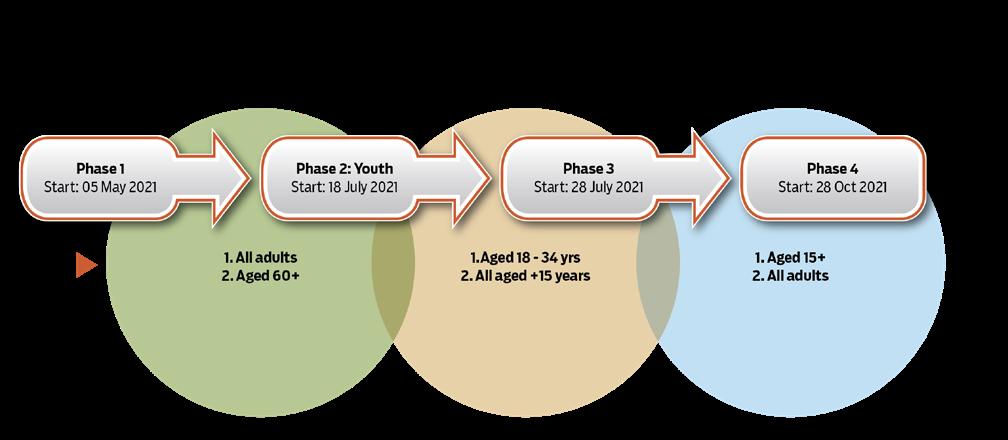
The campaign roll-out took place in four phases as detailed below. The department continued to use multi ple platforms – including TV, radio, online,
social media and out-of-home advertis ing – to reach all segments of the popula tion. The graph below sets out spend on the platforms used.
The vaccine roll-out campaign was car ried on national and pay TV broadcast ers in the country in a phased approach that targeted different age groups.

On TV, adverting on vaccination includ ed a news clock, TV squeeze-backs on SABC, eTV, eNCA and Newzroom Africa. The campaign was also flighted on all African language stations, 18 commercial regional stations, national radio stations,
119 community radio stations, including four community TV stations.
We continued to extend the campaign reach with billboards, wall murals and on line platforms. The added value received was flighting on all stations of 48 spots
per stations and four weeks of social me dia posts on SABC TV and SABC Radio. There were also 407 added value spots including social media posts and inter views with provincial Health MECs on commercial stations.

A total of 256 spots were flighted on SABC 1, SABC 2 and SABC 3. The spots were valued at R4 500 250.00. The campaign had a frequency of 12.3, which meant 26 million viewers saw the advert 12 times.

The messaging for each phase was aligned to each age group to communi cate that vaccines were available to them. To enhance our communication reach, billboards and wall murals were used. The GCIS Media Buying unit had negotiated
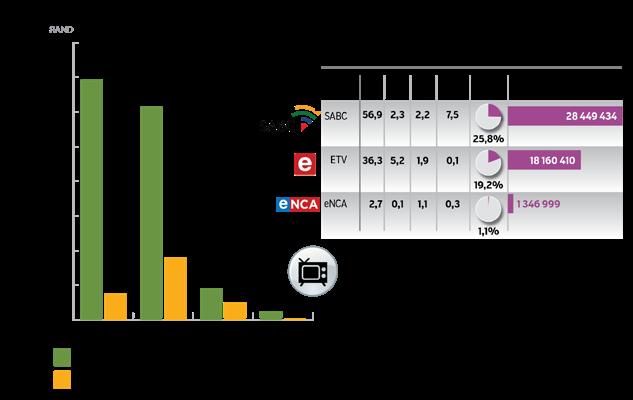
discounts with various media owners of over R20 million.
The campaign was further expanded and enhanced by various social partners such as Pick n Pay, MTN and Vodacom, who used their platforms and retail shops
to communicate the message of vaccina tion.
A total of 85 roadshows targeting high-traffic sites were undertaken across all provinces to encourage communi ties to take advantage of government’s vaccine roll-out programme. Local in fluencers were also engaged to educate communities on registration, benefits and potential side effects of the vaccines.
Our Influencer Campaign, which target ed persons aged between 35 and 49 years old, recruited, screened and appointed social media influencers within different industries, to use their social media plat forms to share pro-vaccination content to their audiences. Over 2 000 people were vaccinated during the roadshows and a further over 1 000 people were vaccinat ed during the Thusong Service Centre Week held in September 2021.
The GCIS developed a digital Corporate Toolkit to provide businesses with digital elements with placeholders for their organisational logos to promote the COVID-19 vaccination key messages in their companies across the country.



Communication was advanced under the campaign: “Stay home – Stay Safe” in level five of the lockdown and then later “Stay Safe” in latter levels. The mass com munication campaign was rolled out to educate the public about COVID-19, mode of transmission, prevention and contain ment measures.
Through these behaviour change com munication campaigns, we disseminated information on the prevention measures such as the wearing of cloth face masks in public and the reorganisation of workplac es, schools, universities, colleges and other public places to limit transmission. Lessons learnt from previous behaviour-change campaigns like the “Abstain, Be Faithful and Condomise” campaign on HIV and AIDS and learning from the private sector the conceptualisation of the campaign.
GCIS provincial offices undertook activa

tions in partnership with key stakeholders, ward councillors, law-enforcement agen cies, traditional leaders and health profes sionals. The department led drop-and-go activations at taxi ranks, malls and fuel sta tions to raise awareness.
In support of the country’s COVID-19 vaccine registration campaign, the GCIS rolled out 112 district and metro-based community activations, in partnership with a range of stakeholders.
Customised mobile trucks were used as an innovative and effective way to reach out to communities and disseminate gov ernment messages using loudspeakers.
The first leg of the mobile truck commu nity activation roadshow commenced at Maponya Mall in Soweto, Gauteng on Sat urday, 29 May 2021 before moving to other provinces. The community activations also used local drama groups to enhance com munication.
Provincial communicators com menced with communication activi ties around COVID-19 from 28 Janu ary 2020. They included the sharing of soundbites, video clips, infograph ics and key messages through the distribution networks for further dis semination.
Information was distributed through community radio talk shows, activa tions at malls and taxi ranks, street intersections and door-to-door visits in communities; local social media awareness and training of govern ment communicators. Internal communicators in govern ment mounted infographics in stra tegic points in their offices, includ

ing restrooms and lifts. An electronic newsletter on Do’s and Don’ts was issued to address the stigma on COV ID-19.
A digital and social media plan was implemented with infographics, social media banners, electronic posters, key messages. It also included the en gagement of followers and oversaw the management of rumours. All GCIS provincial offices conducted community engagements by sharing information with provincial commu nication core teams and other key stakeholders. Loudhailing was one of the most com monly used platforms for mobilisation undertaken by the GCIS district offic
es, in partnership with other spheres of government and entities.
Some 3 189 development communi cation projects in the form of com munity activations, dialogues, media engagements and community out reaches were implemented.
Some 2 554 stakeholder engagement sessions with community media, gov ernment structures, community devel opment workers, traditional author ities, civil society, local business and special formations were implemented.
Four (4) Intergovernmental Commu nication Forum sessions were held to synergise national, provincial and dis trict COVID-19 communication plans. These sessions focused on priority COVID-19 hotspot provinces and dis tricts to support mitigation plans. Some 1.7 million multilingual COV ID-19 leaflets supplied by the DoH
were distributed across the provinces.
Some 48 200 multilingual hotspot posters were distributed and placed at strategic points. A further 12 340 multilingual posters and 12 200 leaf lets on the vaccination campaign from the DoH were distributed across the provinces.
Some 85 COVID-19 vaccination mo bile truck community activations were implemented across the provinces as part of the GCIS COVID-19 vaccine roll-out drive, covering elements of marketing and branding, radio ads and radio dramas.

Health safety messages were shared through procured theatrical drama groups for creative communication and conducted with the maintenance of social distancing.
Digital products such as My District Today newsletter and the GovNews
bulletin were used internally and ex ternally to support the festive sea son campaign, COVID-19 behaviour change campaign and vaccination campaigns.
Content such as infographics, com munication toolkits, media statements and daily messages were communi cated daily through social-media plat forms and the email system.


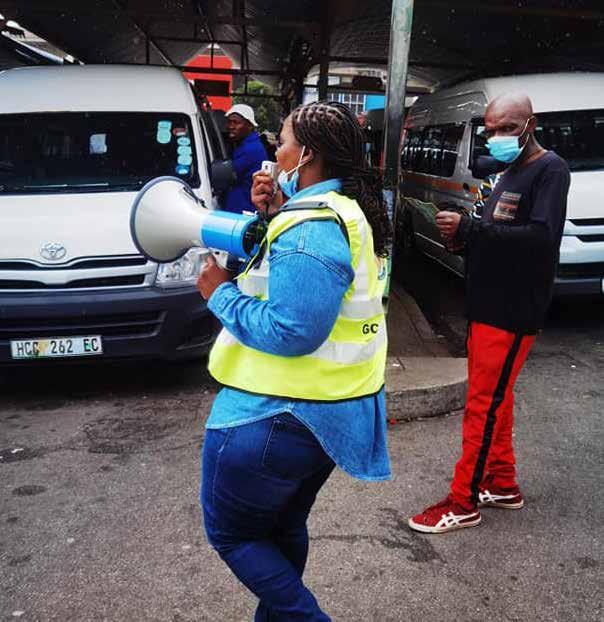
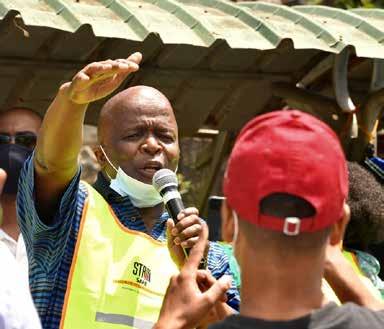


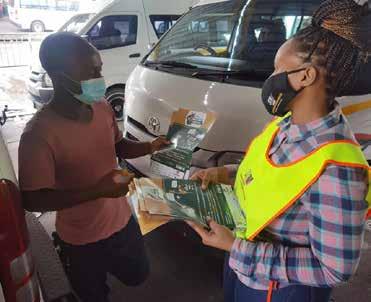

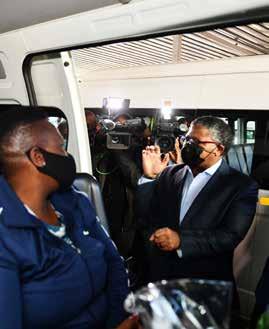


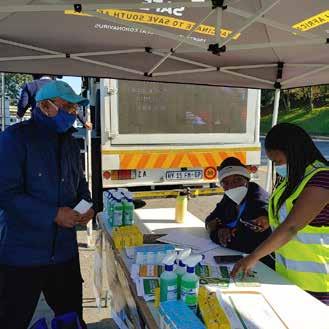

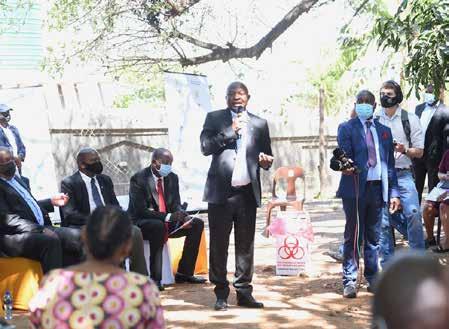
The pandemic not only tested our nation’s resolve but also the robustness of our commu nication system. Government communication rose to the challenge and in doing so we gained valuable ex perience, and saw first-hand what we can achieve as communicators.
The GCIS ensured the achievement of a number of communication milestones within limited financial resources by lev eraging the machinery and platforms of the government communication system. Had communication been properly re sourced, it would have had a far greater impact. Fully resourced communication accompanied by on-the-ground deliv
ery has the tremendous power to effect meaningful change.
Despite the constrained resources, communication on COVID-19 has been highly effective, and it played a critical role in reassuring South Africans and guiding their actions through the onslaught of the pandemic.
The cohesive front by government, business, labour and civil society under the NCP allowed for synergies, efficien cies and combining available resources to reach more South Africans.
Communication helped to educate the public about the virus, articulated the country’s detailed response to fighting it and reassured citizens that government
was doing everything in its power to safe guard both lives and livelihoods. A key part of our communication during COV ID-19 was making people to understand that they were part of the solution. Our communication began to create to getherness in overcoming this extraordi nary situation. Communication helped to strengthen public trust, which was critical in our success in preventing the spread of the virus.
Meanwhile, there is an opportunity for government to continue the partnership with the various stakeholders and apply the communication tactics used during COVID-19 to tackle the country’s other pressing socio-economic challenges.
B4SA Business for South Africa
CCC Communication Command Centre
CCF Community Constituency Front
CoGTA Cooperative Governance and Traditional Affairs
COSATU Congress of South African Trade Unions
COVID-19 Coronavirus Disease
CRRF COVID-19 Response and Recovery Fund
CSA Communication Service Agency
DATT Demand Acceleration Task Team
DG Director-General
DoH Department of Health
EVDS Electronic Vaccination Data System
FBO Faith-based organisation
G-CET Government Communication Excellence Tool
GCIS Government Communication and Information System
GDP Gross Domestic Product
GSM Government Segmentation Model
HoC Head of Communication
IMC Inter-Ministerial Committee
MCA Media Coverage Analysis
MEC
Member of the Executive Council
MP Member of Parliament
NATJOINTS National Joint Operational and Intelligence Structure
NCCC National Coronavirus Command Council
NCP National Communication Partnership
NEDLAC National Economic Development and Labour Council
NGO Non-governmental organisation
NICD National Institute for Communicable Diseases
PLL Provincial and Local Liaison
PSA Public Service Announcement
PVC-SA People’s Vaccine Campaign of South Africa
RCCE Risk Communication and Community Engagement
SACC South African Council of Churches
SADC Southern African Development Community
SANEF
South African National Editors’ Forum
SASSA South African Social Security Agency
SBCC Social and Behaviour Change Communication
UK United Kingdom
USD United States Dollar
VoIP Voice over Internet Protocol
VPNra Virtual Private Network remote access
ZCC Zion Christian Church
In 2022, the GCIS won the Silver PRISM Award for the COVID-19 Vaccine Communication Campaign. The Pan South African Language Board also awarded the Multilingualism Award in the Government/Public Sector category to the department for upholding multilingual communication, particularly during the COVID-19 pandemic.
